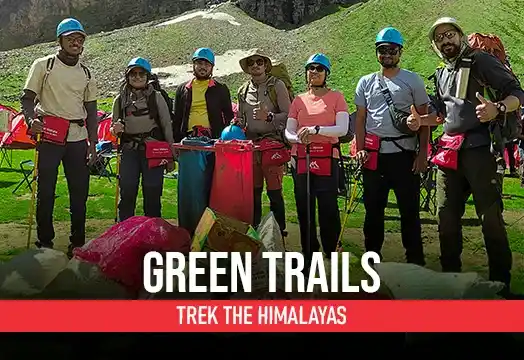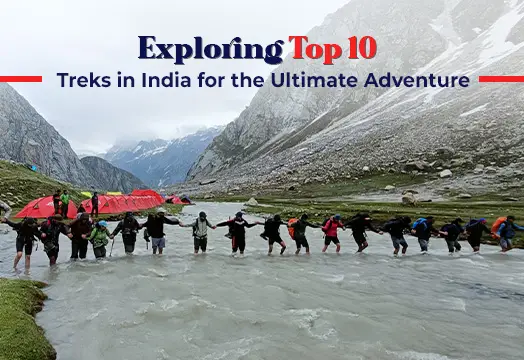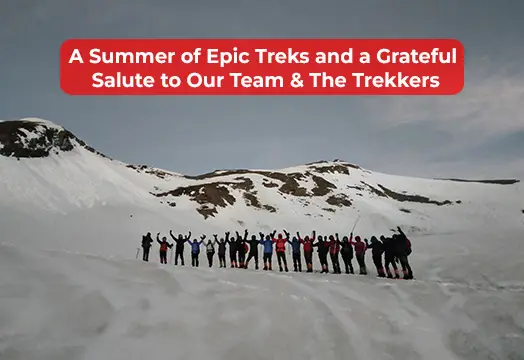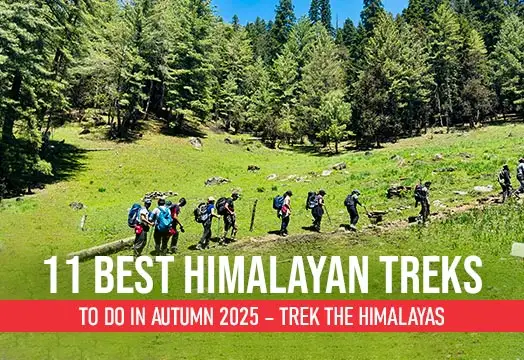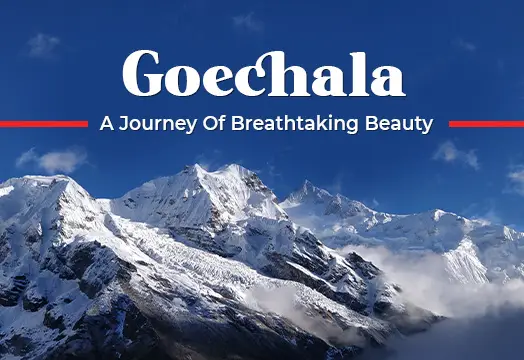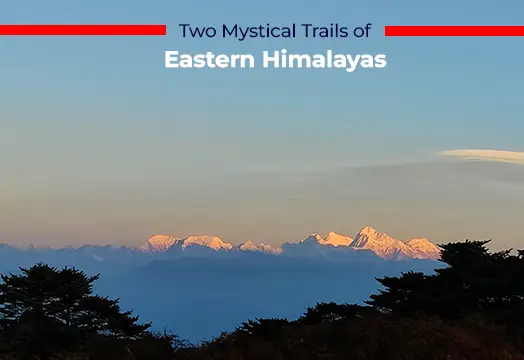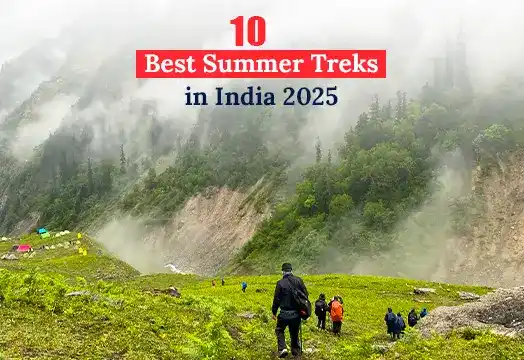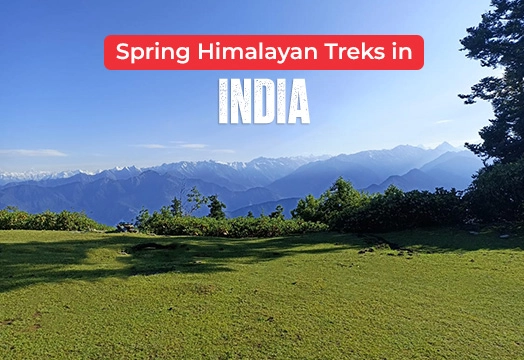
Region
Sikkim | India

Duration
11 Days

Max Altitude
15100 Ft.

Trekking Km
90 KM

Grade
Difficult
Get in Touch with Our Trek Expert
+91 90456 54446 info@trekthehimalayas.comMonday - Saturday: 10 AM to 06 PM (GMT +5:30)
21000 /Person
- September-2025
- October-2025
- November-2025
- March-2026
- April-2026
- May-2026
- 5% GST will be applicable on Trek Cost and Add-ons
- For non Indians 4000 INR extra trek permit fee
- Services Yuksom to Yuksom.
- Meeting Point( Pickup/ Drop Point ):New Jalpaiguri Railway Station (If transportation opted from TTH).
- Reporting Time: 10:00 am
- Drop Time: 4:00 pm to 5:00 pm (Timings are subject to change based on weather and road conditions).
- Please reach New Jalpaiguri a day before to avoid any delays.
Add-ons
Insurance 385
- Insurance is mandatory.
- It is available for Indian citizens only.
- Non-Indians have to take insurance on their own.
- If you already have the high altitude trekking insurance, email for a refund after booking.
- The cancellation policy will be implemented in accordance with the trek cancellation policy.
- For more details about insuranceclick here
Transport 3000
- Transportation from NJP to Yuksom and return is optional.
- Choose add-ons during booking. If missed, log in and add them later.
- Book transportation at least 10 days before the trek.
- Cancellation 4 or more days before the start of the trip results in a 100% cash refund.
- Cancellation less than 4 days from the start of the trip results in a 50% cash refund.
- Cancellations made on the trip date are not eligible for a refund.
Offload 5500
- Backpack offload is optional.
- Choose add-ons during booking. If missed, log in and add them later.
- Book off-load at least 10 days before the trek.
- For offline bookings at the base camp, a convenience fee of Rs. 3500 applies.
- Cancellations made before the trip date will receive a full refund.
Get in Touch with Our Trek Expert
+91 90456 54446info@trekthehimalayas.com
Monday - Saturday: 10 AM to 06 PM (GMT +5:30)
Overview
Trek Name: Goechala Trek
Days: 11
Adventure Type: Trekking
Base Camp: Yuksom
Season:Spring | Summer | Autumn |
Month:March | April | May | September | October | November |
Country: India
Altitude: 15100 Ft.
Grade: Difficult
Rail Head: New Jalpaiguri (NJP)
Stay: Camping (Twin sharing) & Hotel/Guesthouse (Separate male & Female)
Food: Meals while on trek & at Hotel/Guesthouse (Veg & Eggs)
Location: Sikkim
Distance: 90 Km.
Trail Type: Circle trail | Camping in various locations, starting and ending at the same point.
AirPort: Bagdogra International Airport, which is 20 km away from New Jalpaiguri Railway station
Highlights:
- 5% GST will be applicable on Trek Cost and Add-ons
- For non Indians 4000 INR extra trek permit fee
- Services Yuksom to Yuksom.
- Meeting Point( Pickup/ Drop Point ):New Jalpaiguri Railway Station (If transportation opted from TTH).
- Reporting Time: 10:00 am
- Drop Time: 4:00 pm to 5:00 pm (Timings are subject to change based on weather and road conditions).
- Please reach New Jalpaiguri a day before to avoid any delays.

Why is Goechala a Must-Do Trek ?
- The Goechala trek gives you the best views of the mighty Kanchenjunga, third highest peak in the world, glowing beautifully in golden hues at sunrise.
- Along with Kanchenjunga, marvel at the stunning panorama of other high Himalayan peaks, including Pandim, Rathong, Goecha, Japuno and Kabru, forming a beautiful skyline.
- The trek passes through the Kanchenjunga National park, a UNESCO world Heritage, and home to exotic wildlife including the Red pandas, Blue Sheep, Himalayan tahr and many more.
- Enjoy the beauty of Samiti Lake, a pristine alpine lake reflecting the towering peaks. Samiti Lake is a sacred and picture-perfect stop that adds to the trek’s charm.
- Trek through lush forests that come alive in spring with vibrant pink, purple, white and red rhododendrons, creating a fairytale-like setting.
- Experience the thrill of crossing hanging bridges over deep valleys and rushing rivers, adding an adventurous and cinematic touch to your journey.
- It is a less crowded trek that takes you through charming Sikkimese villages, where you can experience warm hospitality, traditional food, and visit Buddhist monasteries.
.webp)
Who Can Participate
- Age Requirement:
- Minimum 16 years
- First-timers are welcome, though prior trekking experience is preferred. Good fitness is a must.
- Fitness Criteria:
- If the trekker wants to carry a backpack then he/she should be able to carry a 10-12 kg backpack. If opt Off-load option then the Trekker should be able to carry 3-5 kg backpack.
- If a trekker's BMI is more or less than the normal range (18-26), please consult our Trek Coordinator before booking.
Special Offer
Special Offer: Trek As Many Times as You Want!
At Trek The Himalayas, we understand that sometimes the unexpected happens, and you may not be able to complete your trek. Whether you are unable to finish the trek, or you’ve successfully completed it and want to experience it again, we have a special offer for you!
Make a single payment and trek the number of times you want.
Terms and Conditions:
- This offer is non-transferable.
- Valid only for Trek The Himalayas limited fixed departures.
- The offer is valid for 5 years from the trek departure date.
- The offer does not apply if the participant has received a cash refund or voucher at the time of cancellation or transferred the trek.
- Participants are not required to pay for the trek cost again but will need to cover transportation and trek permit costs.
- To reserve your spot, you can use our online booking form or simply give us a call. A deposit must be wired, including the initial payment, for confirmation.
- The offer will be activated once the participant reaches the trek base camp/meeting point.
- Trek The Himalayas reserves the right to revoke this offer without refund if a participant violates safety norms, trek rules, or code of conduct; is blacklisted for misconduct, false information, or payment issues; or damages TTH’s brand or reputation.
Goechala Trek Itinerary
Drive from New Jalpaiguri (NJP) to Yuksom
- Altitude Yuksom: 1800 m / 5900 ft
- Drive Distance: 150 km | 8 hrs
- Accommodation: Guesthouse
- Important note for Non-Indians: Foreign nationals will need a Foreigner Trek permit for the Goechala Trek. The permit is issued in Gangtok and cannot be processed in advance, so participants need to come to Yuskom one day early on their own to complete the formalities.
- The charge for obtaining the Foreigner Trek permit is 4000/- INR per person. Pay the amount to the TTH representative and we shall arrange the permit. Additional cost for extra day accommodation in Yuksom and traveling charge is not included in the trek cost.
- Citizens of China, Myanmar, and Bangladesh are not allowed to trek in Sikkim.
The Goechala trek begins from Yuksom. If you have booked your transportation from NJP to Yuksom with Trek the Himalayas, then the team will pick you from New Jalpaiguri Railway Station at the decided time. You will be driven from NJP to Yuksom, from where you will begin the trek on the following day.
Along your drive from NJP to Yuksom, you will pass through scenic roads and the pristine Teesta River gushing alongside as you drive uphill. On the way, there's a stunning Teesta River viewpoint, where you can take in the breathtaking sight of the river flowing gracefully below.
While driving, you’ll come across the Melli Checkpost, where you’ll need to show your ID to enter Sikkim. This is the only gate for both entry and exit. Next, you’ll pass through Jorethang, a great spot to stop for lunch and enjoy some delicious Northeastern cuisine. It's also the last major town with an ATM, so make sure to withdraw enough cash before continuing your journey. After lunch, you will again drive towards Yuksom. Further you would come across Legship, and cross a beautiful bridge on the way. When you reach Yuksom, you will be accommodated in a guest house, where you can rest. Located in West Sikkim, the historic town of Yuksom was once the first capital of Sikkim. Serving as the gateway to Mt. Kanchenjunga, this picturesque town is steeped in history and cultural significance. Here, you can also learn about the religious and cultural fables of Sikkim and get a close look at the traditions and the community life.
Around late evening, the Trek Leader will give you the main briefing about the rules to be followed at the trek, the weather conditions up in the mountains, and all the essentials that you need to carry with you on the trek. After this, you can have dinner and rest.
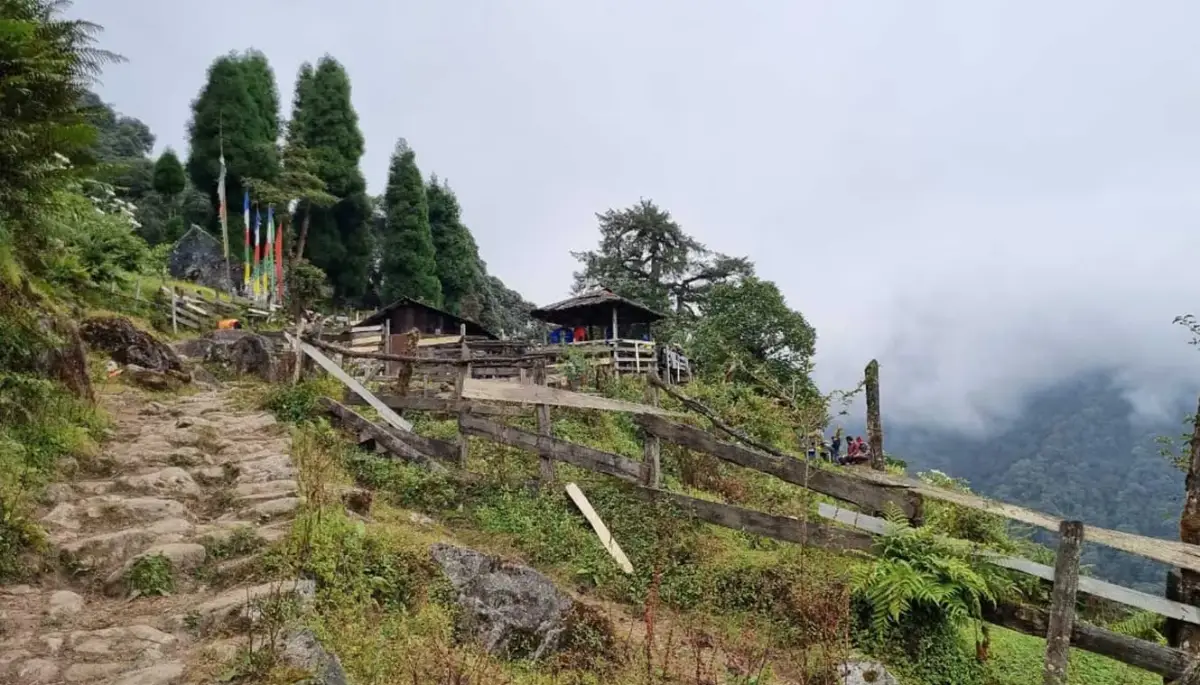
Yuksom to Sachen
- Altitude (Sachen): 2,200 m / 7,300 ft
- Trek Distance: 8 km | 6 hr approx.
- Accommodation: Tents
- Leeches: There is a high chance of encountering leeches, so remember to carry salt or spray with you.
Today marks the first day of trekking of your Goechala trek as you head towards Sachen, your first campsite. Start your morning with a hearty breakfast before setting off on the trek. At the beginning of the trail, you would pass through a few small wooden houses and agricultural farms, which gradually fade away as you leave civilization behind and step into nature. The mobile network becomes unreliable, and you won’t find any shops along the way, so it’s best to be prepared.
The trek begins as you enter the majestic Kanchenjunga National Park through a large welcoming gate. Soon, you'll reach the Phakhola Bridge, the first of three charming bridges you’ll cross along the way. Each bridge offers a peaceful pause, surrounded by the serene beauty of flowing rivers and dense forest. The trail ascends along the gorge of the Prek Chhu river, weaving through dense forests of Broadleaf, Golden and Silver Oak. As you walk, you’ll also spot vibrant Himalayan wildflowers and delicate orchids blooming along the path. A packed lunch will be provided, which you can enjoy on the way to Sachen.
From the first suspension bridge, the trail is moderate until you reach the second bridge. After that, a steep ascent leads to the third bridge, which marks your final stretch to Sachen. The Sachen campsite is nestled in a small clearing within the dense forest, with the soothing sound of the Prek Chu River flowing further down the valley. If you listen closely, you can hear the gentle gushing of the river from the campsite. After a long day of trekking, exhaustion may set in, so it’s best to get a good night’s rest. Sleeping early will help you recharge and prepare for the adventure that awaits you the next day.
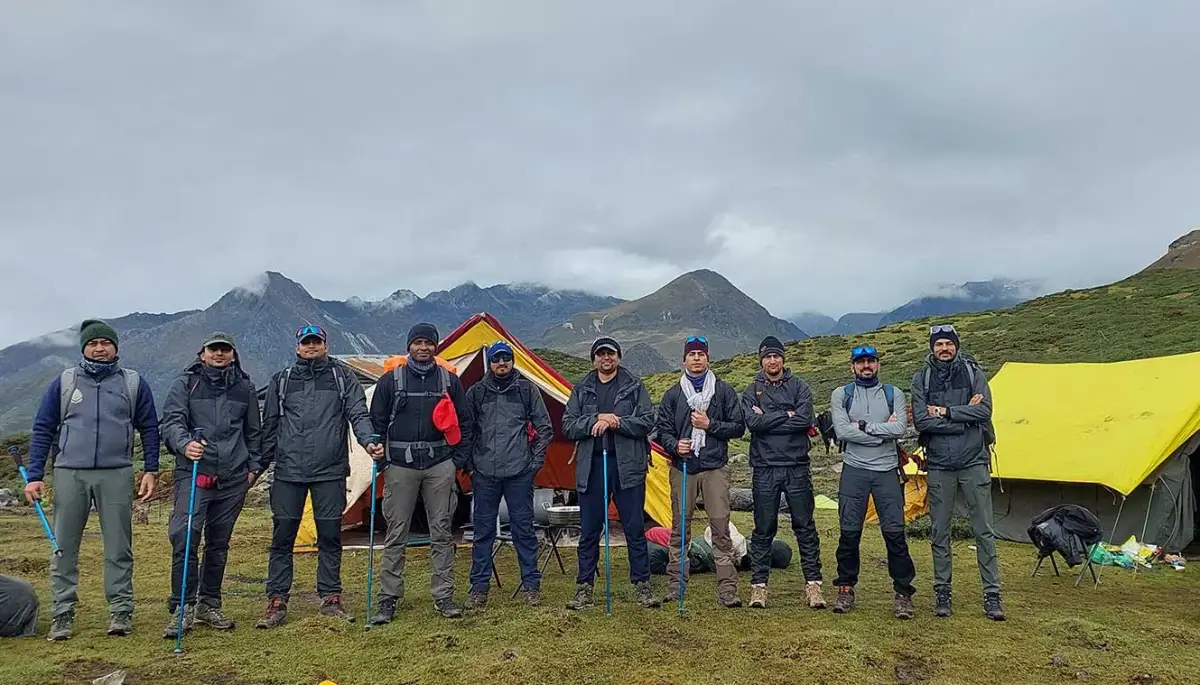
Sachen to Tshokha via Bakhim
- Altitude:
- Bakhim: 2,650 m / 8,700 ft
- Tshoka: 3,000 m / 9,800 ft
- Trek Distance: 7 km | 5 hr approx.
- Accommodation: Tents
On the third day of your trek, you’ll journey from Sachen to Tshokha, passing through the quaint hamlet of Bakhim. Wake up to a magical morning filled with the melodious chorus of Himalayan birds, their songs echoing through the forest like nature’s own symphony. The crisp mountain air and golden sunlight filtering through the trees make the moment unforgettable. After soaking in the peaceful surroundings and enjoying a hearty breakfast, you’ll set off on the trail, energized and ready for the scenic ascent ahead.
Today’s trail leads you through a dense forest with gentle ups and downs, surrounded by the calming sounds of nature. After some trekking, you’ll arrive at the Prek Chu Bridge, a charming spot over a rushing river. From there, the path continues through thick Maple and Oak forests, where the chirping of birds fills the air. If you're lucky, you might catch a glimpse of the vibrant Yellow-billed Blue Magpie. After the bridge, a steep zigzag ascent begins, eventually bringing you to the peaceful settlement of Bakhim.
Bakhim is a popular rest stop for trekkers, offering stunning views of Yuksom Valley. Here you can refill your water bottles, and can have light snacks. After a short pause, you will continue your ascent towards Tshokha. The stretch from Bakhim to Tshoka is extremely scenic with Magnolia Trees around. These magnolia’s bloom during early spring to late summer, turning the trails even more pretty with pink and white colors.
When you reach Tshoka, you’ll see a few small huts belonging to the forest and tourism department. Tshoka is a beautiful campsite, with snow-covered peaks visible in the distance, including the majestic Mt. Pandim and Tenzing Khang. Not far from the campsite is the Tshoka monastery, which you can visit in the evening. With a lake beside, it’s a quiet, peaceful place, perfect for spending a little time before nightfall. End your day by soaking in the calm surroundings and getting a good rest for the next day’s adventure.
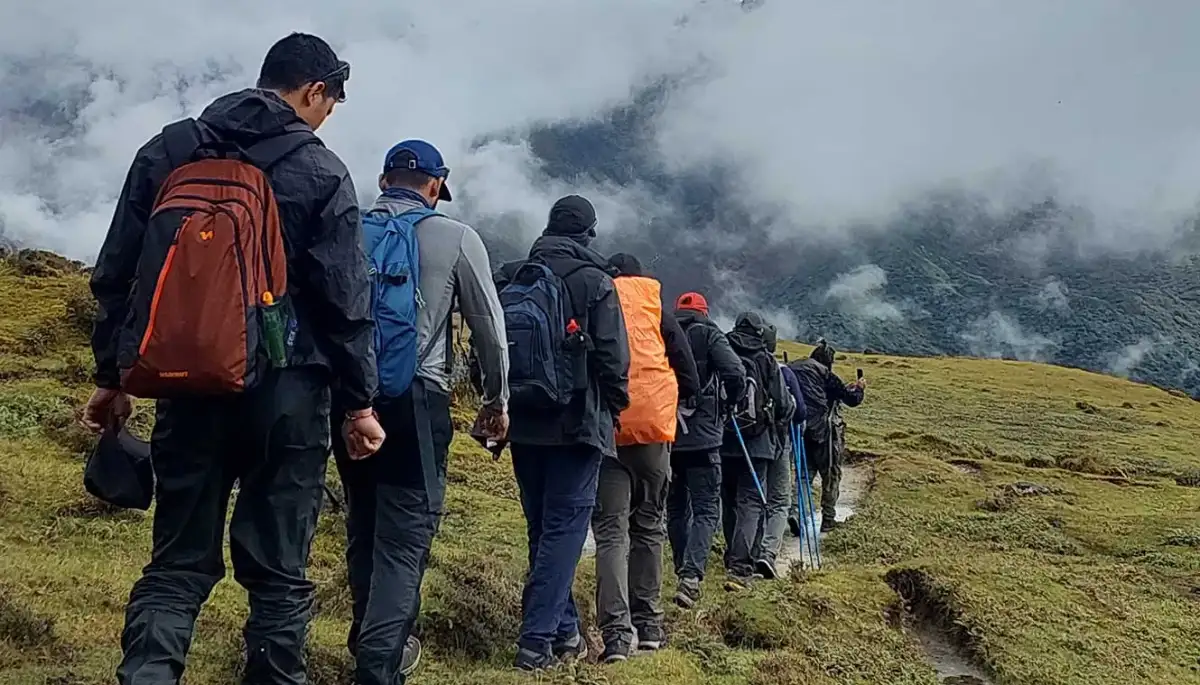
Tsokha to Dzongri via Phedang
- Altitude:
- Phedang: 3,700 m / 12,100 ft
- Deorali Top: 4,000 m / 13,100 ft
- Dzongri: 4,000 m / 13,100 ft
- Trek Distance: 8 km | 8 hr approx
- Accommodation: Tents
It is the fourth day of your journey and you will trek from Tshoka to Dzongri. Start your day by waking up in the serene mountain surroundings of Tshoka. Enjoy a nutritious breakfast and get ready for the day's trek. Today's trek is one of the most scenic yet challenging sections of the journey.
The day’s trek begins with a gentle ascent into the forest, where the cool mountain air and the scent of damp earth welcome you. After a while, you’ll encounter a picturesque wooden pathway winding through a dense forest of Rhododendrons. During spring, the trail comes alive with vibrant red and pink blooms, creating a stunning canopy of flowers overhead. The sight of these blossoms makes the stretch feel like a living painting. Walking along this trail is a truly enchanting experience, the wooden planks creaking softly beneath your feet, while the vibrant flowers and stillness of the forest create a dreamlike atmosphere. As you move forward, the path begins to climb more steeply, weaving through thick greenery and tall trees. With every step, the silence of the forest deepens, eventually leading you to the peaceful meadow of Phedang.
Phedang is a beautiful resting point lined with prayer flags. This is a great spot to take a short break before continuing. Carry enough water, as there are no water sources along the way. The altitude gain is significant, increasing the risk of Acute Mountain Sickness. Trek at a steady pace, take regular breaks, and stay hydrated and energized to avoid discomfort. From Phedang, the trees start to thin out, and the trail is really steep and tests your endurance and strength. After trekking for a while, you’ll arrive at Deorali Top, a beautiful viewpoint with wide panoramic views of the Himalayas. On a clear day, you can even spot the mighty Mt. Kanchenjunga and Pandim standing tall among the clouds. It’s a perfect place to pause, catch your breath, and take in the beauty around you.
By the time you reach Deorali Top, you’ll have crossed the toughest part of today’s trek. From there, the trail becomes easier and more gradual. The wind here can be quite strong, and it gets really cold, so make sure to dress warmly. Once you arrive at Dzongri, settle into your campsite, enjoy a hot, comforting dinner, and get some much-needed rest to prepare for the adventures waiting for you the next day.
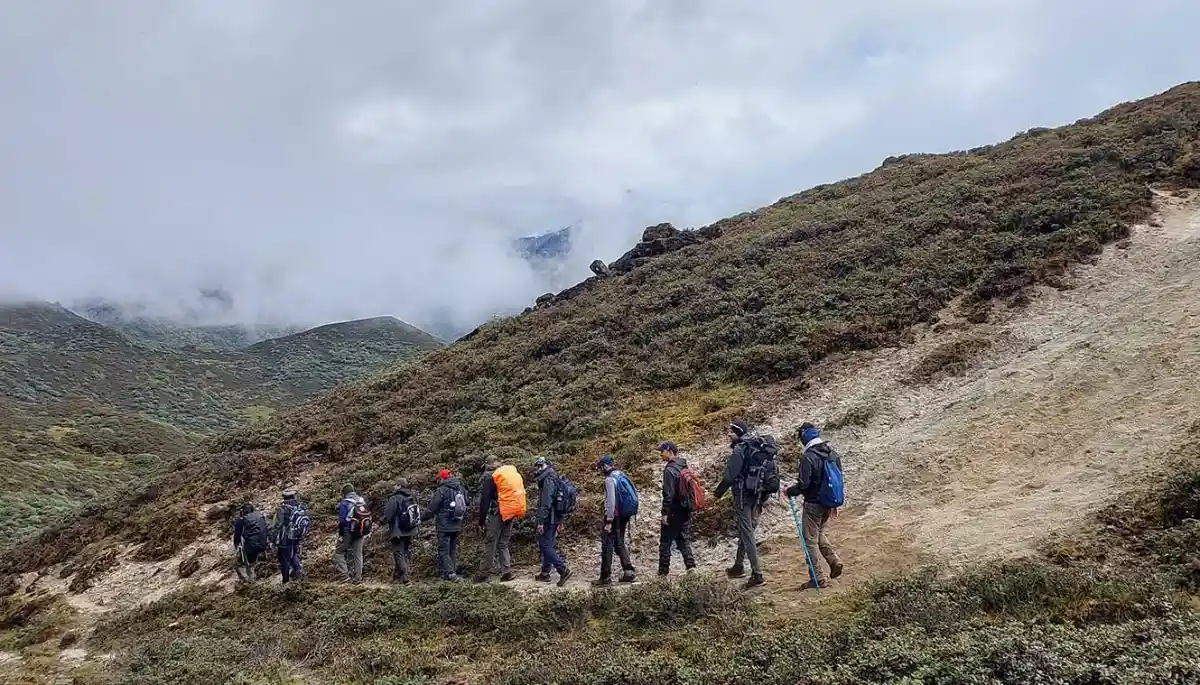
Acclimatization Day at Dzongri
- Altitude (Dzongri Top): 4,150 m / 13,700 ft
Today is a rest and acclimatization day at Dzongri, but you have the chance to witness a pleasant sunrise from Dzongri Top with a short trek.
The trek starts early in the morning and takes about an hour to reach Dzongri Top. You would reach the Top by the time of sunrise and witness an amazing morning. As the sun rises, you’ll see the majestic Kanchenjunga Peak glowing in the soft morning light. From the top, you can admire stunning Himalayan peaks, including North and South Kabru, Mt. Pandim, Kokthang, Narsing, Kumbhkarna, Jhopuno, Tenzing Khang, Simvo, and Frey Peak. Colorful Tibetan prayer flags flutter in the breeze, adding to the charm of this magical place. Watch as the snow-covered mountains slowly change color as the sun rays hit them. On a clear day, Mt. Kanchenjunga appears golden as the sunlight reflects off its snowy peaks. The view is truly unforgettable.
Take your time at the top, soak in the views, click amazing pictures, and enjoy the peaceful surroundings. After that, head back to the campsite. Since the previous day was quite challenging with a steep altitude gain, your body needs time to adjust. Spend the rest of the day relaxing, enjoying good food, and bonding with fellow trekkers.
It’s best to avoid sleeping during the day. Instead, take short walks around the campsite to stay active and engaged. The stunning landscapes and snow-capped mountains will refresh your mind and body. Capture some beautiful moments, relax, and prepare for the next day's trek.
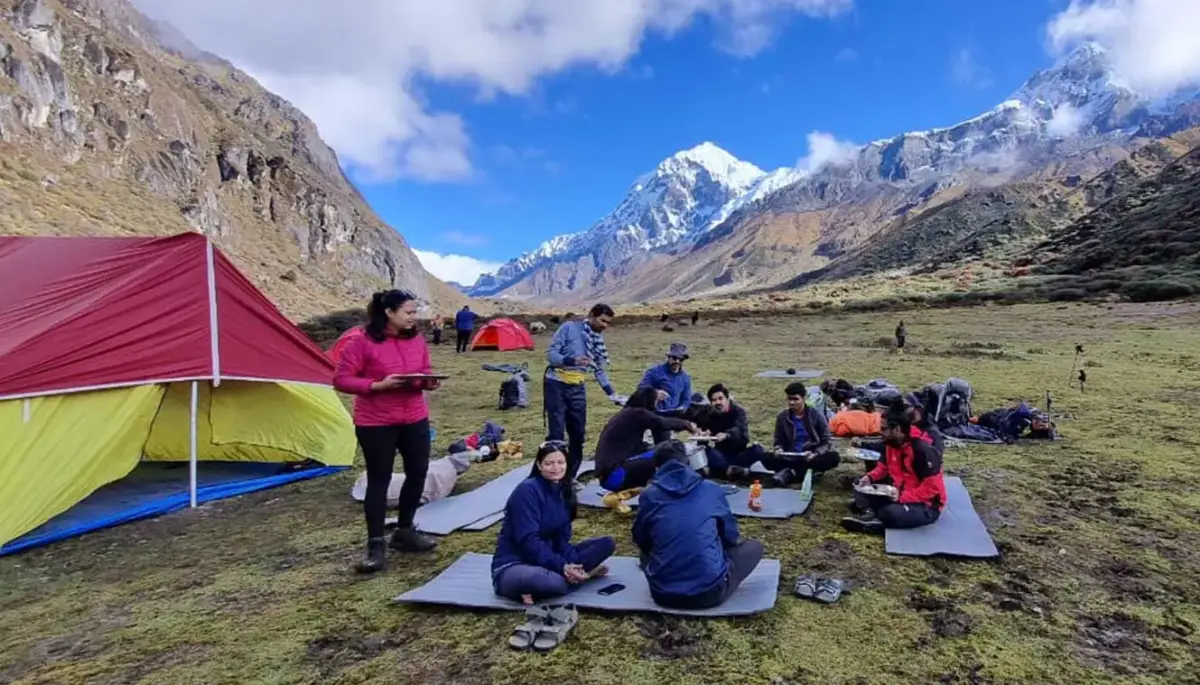
Dzongri to Thansing via Kokchhurung
- Altitude:
- Kokchhurung: 3,700 m / 12,100 ft
- Thansing: 3,950 m / 13,000 ft
- Trek Distance: 10 km | 7 hr approx
- Accommodation: Tents
Today is the sixth day of your journey, and you will be trekking from Dzongri to Thansing via Kokchhurung. Start your morning with beautiful views and a wholesome breakfast before setting off on your trek.
The trail takes you through wide, open meadows. Walking through these meadows is a wonderful experience, though it can test your patience at times. Often, clouds roll in and cover the views, but soon the sky clears up again. Watching the landscapes change like this feels like being part of a dream. After walking through the meadows for a while, you’ll enter a high altitude thicket filled with rhododendron trees. As you move through the thicket, you’ll hear the calming sounds of birds singing and leaves rustling in the wind. It’s a peaceful stretch, and you might spot colorful birds. After crossing this section, the trail descends steeply leading you to Kokchhurung. At Kokchhurung, there’s a small trekkers’ hut where many travelers choose to rest while heading back. However, the space in the hut is quite limited, and even finding a good spot to pitch a tent can be tricky. It’s a good idea to take a short break here to rest your legs and refill your water bottles.
From Kokchhurung, the trail heads further toward Thangsing. Further you will come across a bridge. After crossing it, you will again enter into the forest, the trail gently climbs uphill, not too steep or tiring. The sound of the river flowing nearby, mixed with the songs of birds, creates a beautiful, soothing atmosphere for trekking. After crossing the slightly steep section, a vast meadow will appear in front of you, signaling your arrival at the Thangsing campsite.
Nestled at the base of Mt. Tenzing Khang, this site offers stunning close-up views of the majestic Himalayan peaks. On clear days, you’ll catch a glimpse of the Kanchenjunga shoulder and the towering Mt. Pandim in all their glory. Upon reaching the campsite, enjoy a hot lunch and spend the rest of the day relaxing. The temperature at Thangsing can drop significantly, so be sure to layer up for warmth. A light meal is recommended, as heavy food can cause discomfort at higher altitudes. Staying hydrated is also essential to help your body adjust.
As night falls, retreat to your tent and get a good rest in preparation for the journey ahead.
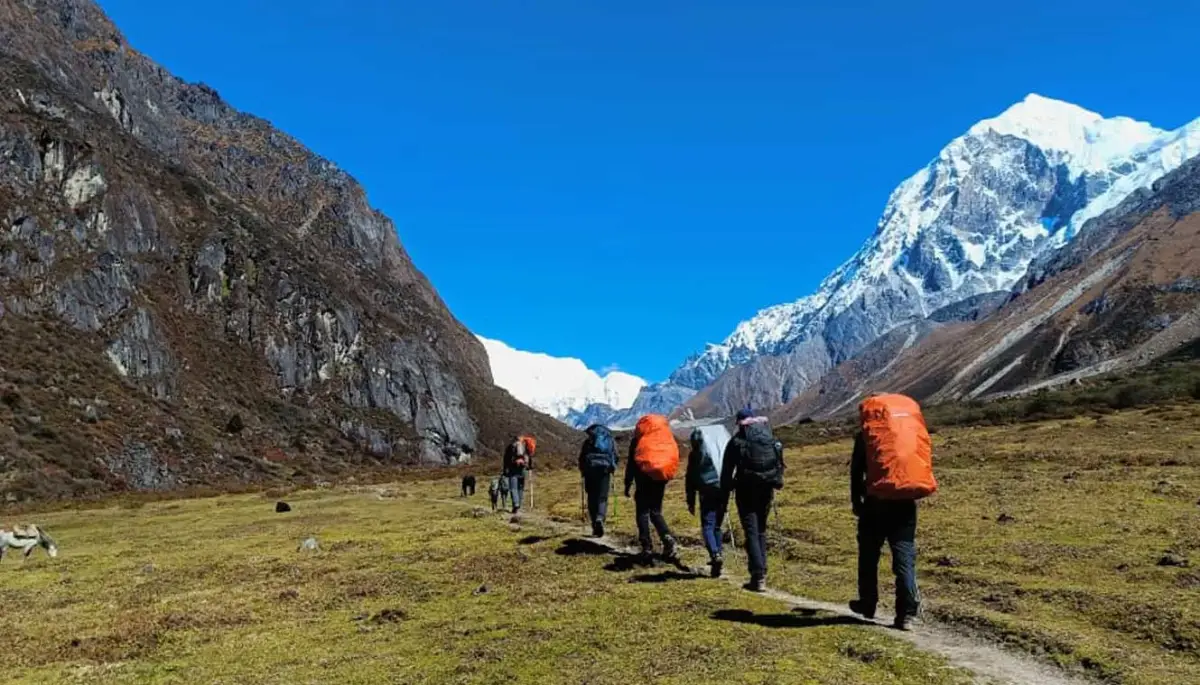
Thansing to Lamuney
- Altitude Lamuney: 4,150 m / 13,600 ft
- Trek Distance: 4 km | 3 hr approx.
- Accommodation: Tents
- Discover the Significance of Lamuney Campsite in the Goechala Trek by Clicking Here
Today, you will trek from Thansing to Lamuney, which is the easiest stretch of the Goechala trek. Since the trek is short and less demanding, you can sleep in a little longer this morning. After enjoying a hearty breakfast, you’ll set off for Lamuney. The trail is mostly flat, making it a relaxed and pleasant walk. In about three hours, you will reach the next campsite. This easy trek allows your body to rest and adjust to the increasing altitude. As you walk through vast meadows and open pastures on both sides, soak in the beauty of the stunning landscapes around you. The trail remains simple and mostly flat.
Once you arrive at Lamuney, settle in and enjoy a warm lunch while enjoying the peaceful mountain views. The campsite is in a wide-open area, offering an amazing sight of the Kanchenjunga. Since it is located near the Prek Chu River, the surroundings are incredibly serene, and you can take short walks around to explore. Later in the evening, your trek leader and guide will brief you about the most important day of the trek, the journey to the Goechala Summit. They will explain the trail, what to expect, and share useful tips for the big day ahead.
As night falls, the sky at Lamuney transforms into a mesmerizing display of stars, making for a mesmerizing sight. Since the next day’s trek starts early in the morning, it is best to sleep early and get proper rest.
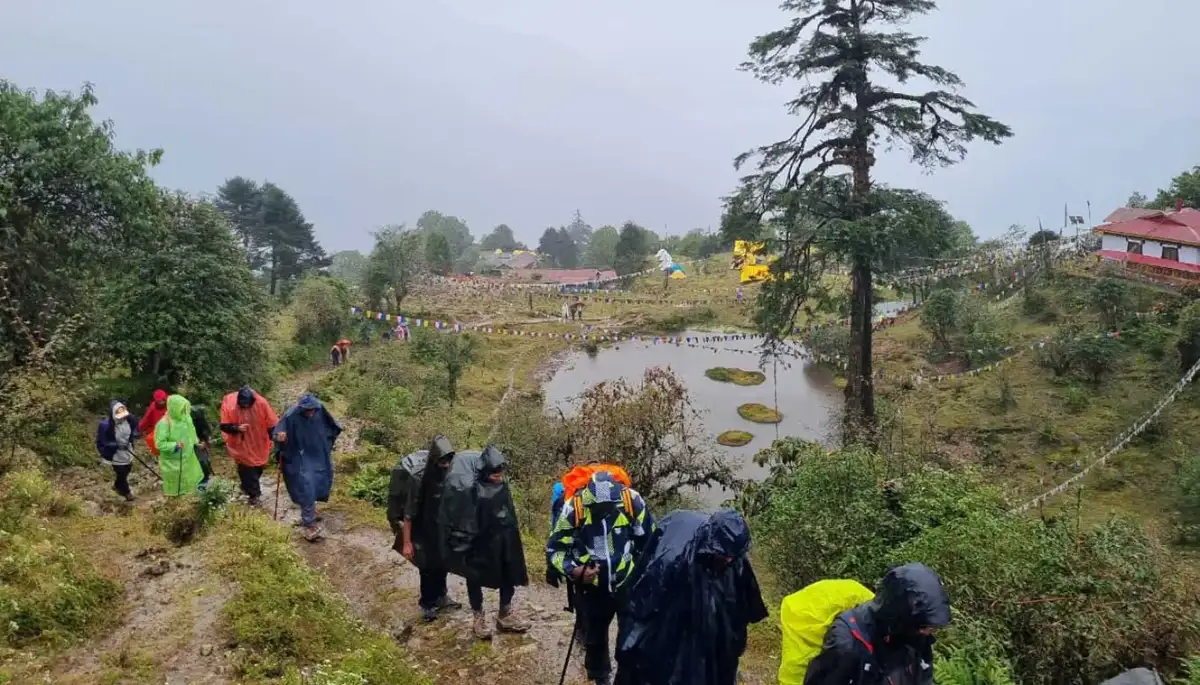
Lamuney to Goechala via Samiti Lake back to Thansing/Kokchhurung
- Altitude:
- Samiti Lake: 4,300 m / 14,200 ft
- Goecha La viewpoint 1: 4,600 m / 15,100 ft
- Thansing: 3,950 m / 3,000 ft
- Trek Distance: 15 km | 10-11 hr approx
- Accommodation: Tents
Today is a big and challenging day as you trek from Lamuney to Goechala via Samiti Lake and then return to Thangsing or Kokchhurung. Your journey will begin early in the morning, allowing you to witness a splendid sunrise from the viewpoint. The sight of the first golden rays lighting up the mighty Himalayas is one of the most magical moments of the Goechala trek. To ensure a smooth return, pack your bags the night before so that after the trek, you can have lunch and head to the lower campsites without delay.
The trek starts with an uphill climb over rocky moraines, followed by a gradual walk leading to Samiti Lake. While trekking up, it will still be dark, so you won’t fully see the lake’s beauty yet, but you can take your time to admire it on the way back. From Samiti Lake, the path ascends again, leading you to the Goechala Viewpoint. The trail to the ridge from the lake is narrow, so walk carefully. By the time you reach the viewpoint, the sun will just be rising. Most of this trek will take place during the night, so be sure to carry your head torch for proper visibility.
Reaching the viewpoint at sunrise is an unforgettable experience. Before you stand the majestic Mt. Kanchenjunga, along with other towering Himalayan peaks covered in pristine snow. You will spot prominent peaks like Pandim, Kanchenjunga, Tenzing Thang. As the golden morning light touches Kanchenjunga, it feels almost surreal, like a dream brought to life. The Himalayan peaks appear incredibly close, their vastness filling you with awe. The stunning sunrise, combined with the joy of reaching this point, makes all your efforts worthwhile. This is one of the most rewarding moments of the trek, leaving you speechless with its beauty.
After spending time soaking in the incredible views, you will begin your descent towards Lamuney. On the way back, you will stop by the serene Samiti Lake. Nestled among rugged terrains, the lake’s crystal-clear waters reflect the surrounding peaks, creating a picture-perfect scene. You can take a peaceful walk around the lake, capture beautiful photos and videos, and simply sit by the shore, listening to the gentle sounds of water. After taking in the beauty of the lake, you will continue trekking back to Lamuney, where an early hot lunch awaits. Depending on the weather, you will then trek further down to either Thangsing or Kokchhurung.
Once you reach your final campsite for the day, you can settle into your tent and get a well-deserved rest after this incredible adventure.
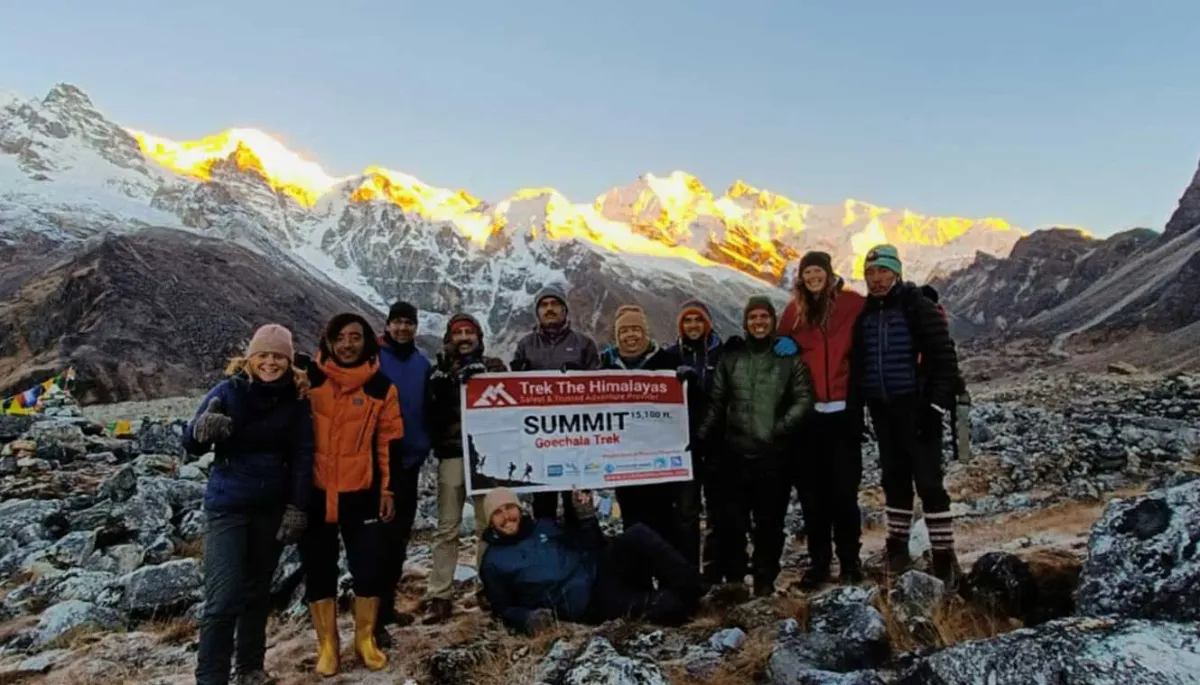
Thansing/Kokcharang to Tshokha via Phedang
- Altitude:
- Phedang: 3,700 m / 12,100 ft
- Tshoka: 3,000 m / 9,800 ft
- Trek Distance: 16 km | 7 hr approx
- Accommodation: Tents
Today, you will trek back to Tshoka. Wake up at the beautiful campsite, enjoy a hearty breakfast, and get ready for the trek ahead.
The journey back starts early, so you can reach Tshoka before it gets dark.
Today you will take a different path rather than retracing your path through the same route. From Kokchorrung there is a hidden path into the forest. The trails through the forest are defined and so thin that only one person can walk at a time. Today’s trek is a mix of gentle climbs and easy descents through thick, green forests. This forest is filled with different kinds of trees, including rhododendrons. If you visit during spring, the trail looks extra beautiful with bright rhododendron flowers blooming all around, adding a splash of color to your walk.
Remember to follow the trekking tips your trek leaders have shared, and be careful with your steps, especially while going downhill. The path can get a little slippery in places, so it’s best to move steadily and enjoy the peaceful forest around you. The trail is quite direct without any diversion, meaning you will walk through dense forests for long stretches. The forest opens up only at Phedang, which is the first stop on your way down, and takes about 4 to 5 hours to reach. A packed lunch will be provided for you, and once you arrive at Phedang, you will take a short break to rest and enjoy your meal. The cool breeze and soothing sounds of nature will refresh you, helping you regain energy for the next stretch of the trek.
After resting, you will continue your descent toward Tshoka, following the same route you took earlier. The path winds through thick Rhododendron forests, offering vibrant scenery that makes the walk enjoyable. The descent from here is much gentler, making it a pleasant trek. Upon arriving at Tshoka, you will settle into your campsite for the night. Since tomorrow is another long trek back, it’s best to sleep early and get plenty of rest.
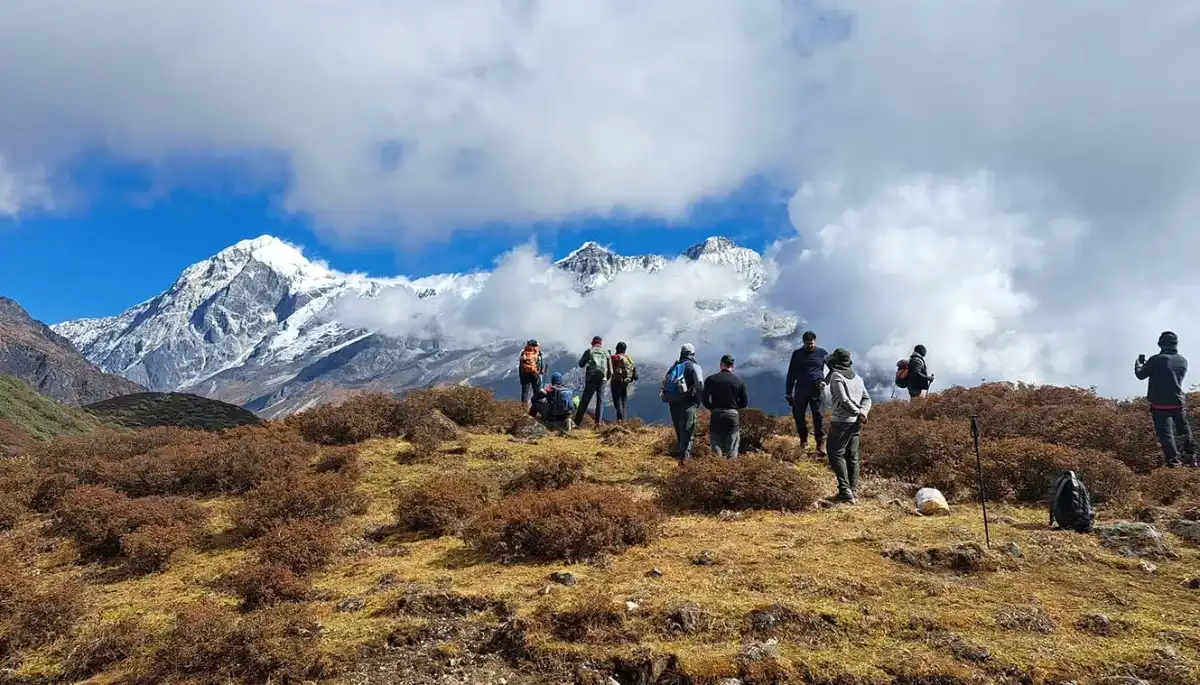
Tshokha to Yuksom via Bakhim and Sachen
- Altitude Yuksom: 1,750 m / 5,700 ft
- Trek Distance: 15 km | 8 hr approx
- Accommodation: Tents
Today, you will make your way back to Yuksom, passing through Prek Chu River, Bakhim, and Sachen.
Your day will start early, as you have a long distance to cover. Enjoy a hearty breakfast in the mountains before setting off on the trail. You will follow the same scenic route you took while trekking from Yuksom to Tshoka. The path is mostly gentle, with a serene and quiet environment, making the journey more enjoyable. On your way down, you will cross the three picturesque iron bridges again and pass through Bakhim and Sachen. Since the trek is mostly downhill, it can put some strain on your knees, so take it slow and maintain a steady pace.
The final stretch includes a short uphill climb before you reach Yuksom. Though it may feel a bit tiring, it’s only for a few meters. Once you cross this, you will find yourself back in the familiar surroundings of Yuksom. Telecom networks will return, allowing you to connect with friends and family. For those eager to explore, Yuksom has much to offer. You can stroll around, learn about its rich history, and experience the local culture. The people here are warm and welcoming, making every interaction enjoyable. Visit the monasteries, browse through the local handicraft market, or pick up souvenirs as a memory of this incredible trek. Finally, settle into your guest house, enjoy a wholesome meal, and get some well-deserved rest.
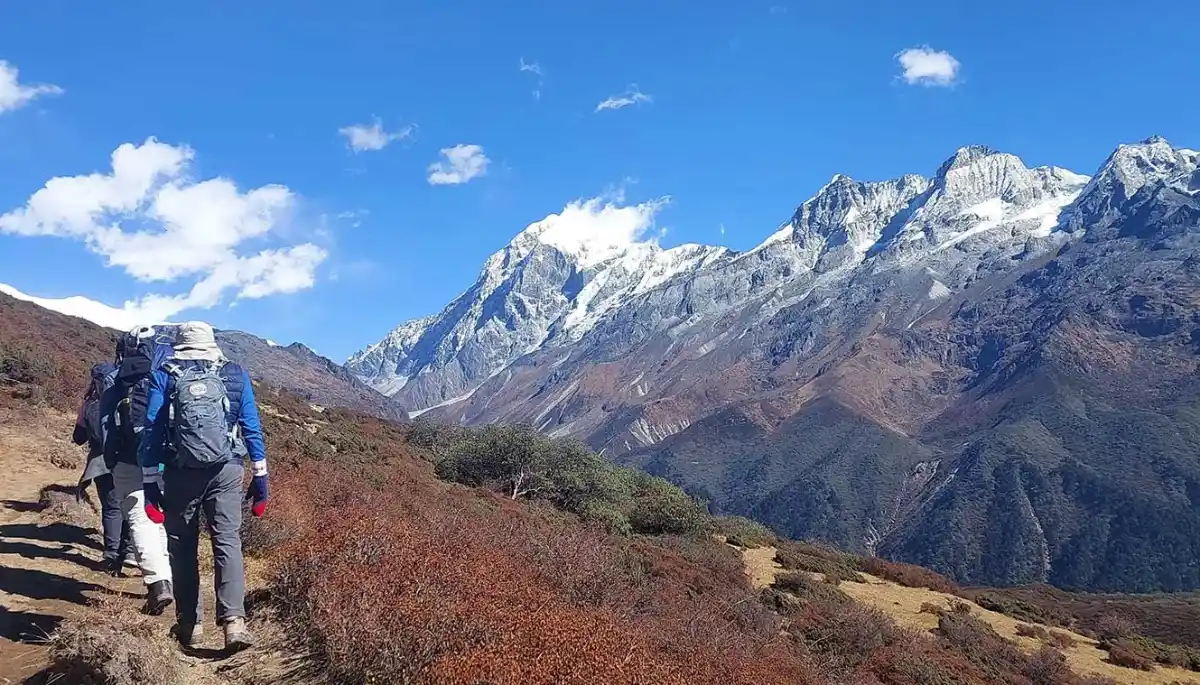
Drive from Yuksom to NJP
- Drive Distance: 150 km | 8 hrs
Today is the last day of your journey in the peaceful mountains, and it's time to head back from Yuksom to NJP. You'll start early since it's a long drive ahead. The distance is about 150 km and can take 7 to 8 hours, depending on traffic. You'll reach NJP by late evening. The road back follows the same beautiful route, with the Teesta River flowing alongside. As you drive, take a moment to think about the wonderful memories you made in the mountains and enjoy good conversations with your fellow trekkers.
Once you reach NJP, you can continue your journey further or stay overnight. If time allows, explore the local Hong Kong and Bidhan markets, shop for handicrafts, and try some delicious local food. When the time comes, move ahead on the next part of your journey.
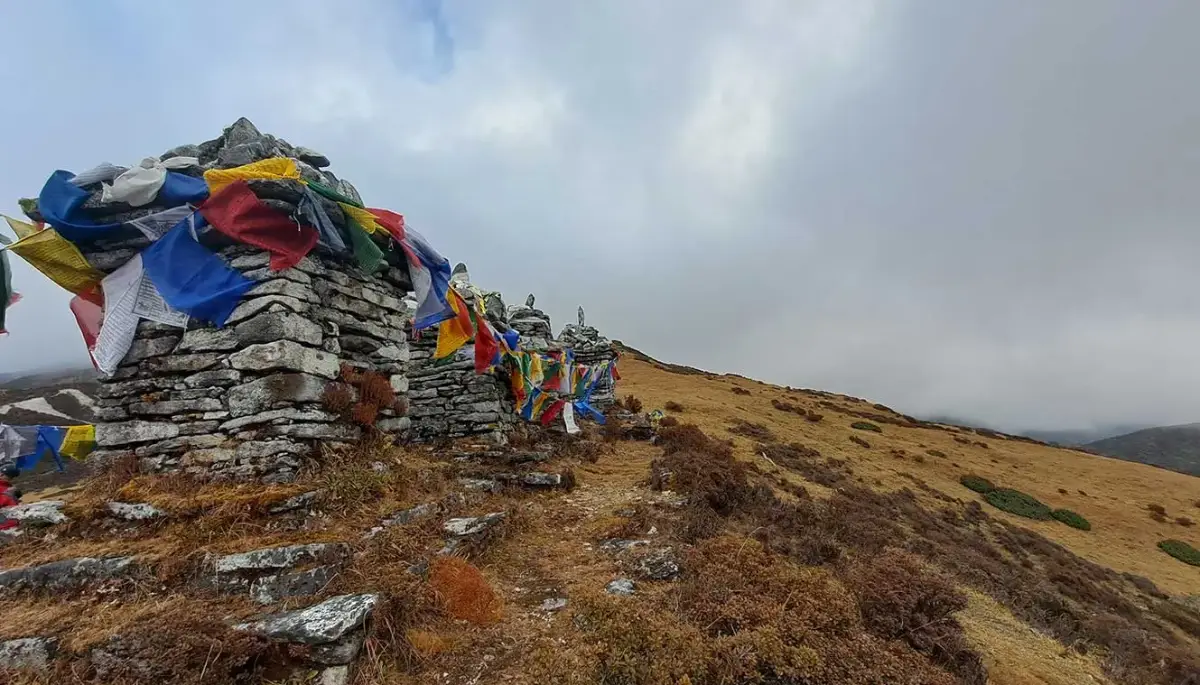
Day-1: Drive from New Jalpaiguri (NJP) to Yuksom
- Altitude Yuksom: 1800 m / 5900 ft
- Drive Distance: 150 km | 8 hrs
- Important note for Non-Indians: Foreign nationals will need a Foreigner Trek permit for the Goechala Trek. The permit is issued in Gangtok and cannot be processed in advance, so participants need to come to Yuskom one day early on their own to complete the formalities.
- The charge for obtaining the Foreigner Trek permit is 4000/- INR per person. Pay the amount to the TTH representative and we shall arrange the permit. Additional cost for extra day accommodation in Yuksom and traveling charge is not included in the trek cost.
- Citizens of China, Myanmar, and Bangladesh are not allowed to trek in Sikkim.
Day-2: Yuksom to Sachen
- Altitude (Sachen): 2,200 m / 7,300 ft
- Trek Distance: 8 km | 6 hr approx.
- Leeches: There is a high chance of encountering leeches, so remember to carry salt or spray with you.
Day-3: Sachen to Tshokha via Bakhim
- Altitude:
- Bakhim: 2,650 m / 8,700 ft
- Tshoka: 3,000 m / 9,800 ft
- Trek Distance: 7 km | 5 hr approx.
Day-4: Tsokha to Dzongri via Phedang
- Altitude:
- Phedang: 3,700 m / 12,100 ft
- Deorali Top: 4,000 m / 13,100 ft
- Dzongri: 4,000 m / 13,100 ft
- Trek Distance: 8 km | 8 hr approx
Day-5: Acclimatization Day at Dzongri
- Altitude (Dzongri Top): 4,150 m / 13,700 ft
Day-6: Dzongri to Thansing via Kokchhurung
- Altitude:
- Kokchhurung: 3,700 m / 12,100 ft
- Thansing: 3,950 m / 13,000 ft
- Trek Distance: 10 km | 7 hr approx
Day-7: Thansing to Lamuney
- Altitude Lamuney: 4,150 m / 13,600 ft
- Trek Distance: 4 km | 3 hr approx.
- Discover the Significance of Lamuney Campsite in the Goechala Trek by Clicking Here
Day-8: Lamuney to Goechala via Samiti Lake back to Thansing/Kokchhurung
- Altitude:
- Samiti Lake: 4,300 m / 14,200 ft
- Goecha La viewpoint 1: 4,600 m / 15,100 ft
- Thansing: 3,950 m / 13,000 ft
- Trek Distance: 15 km | 10-11 hr approx
Day-9: Thansing/Kokcharang to Tshokha via Phedang
- Altitude:
- Phedang: 3,700 m / 12,100 ft
- Tshoka: 3,000 m / 9,800 ft
- Trek Distance: 16 km | 7 hr approx
Day-10: Tshokha to Yuksom via Bakhim and Sachen
- Altitude Yuksom: 1,750 m / 5,700 ft
- Trek Distance: 15 km | 8 hr approx
Day-11: Drive from Yuksom to NJP
- Drive Distance: 150 km | 8 hrs
Goechala Trek Graph
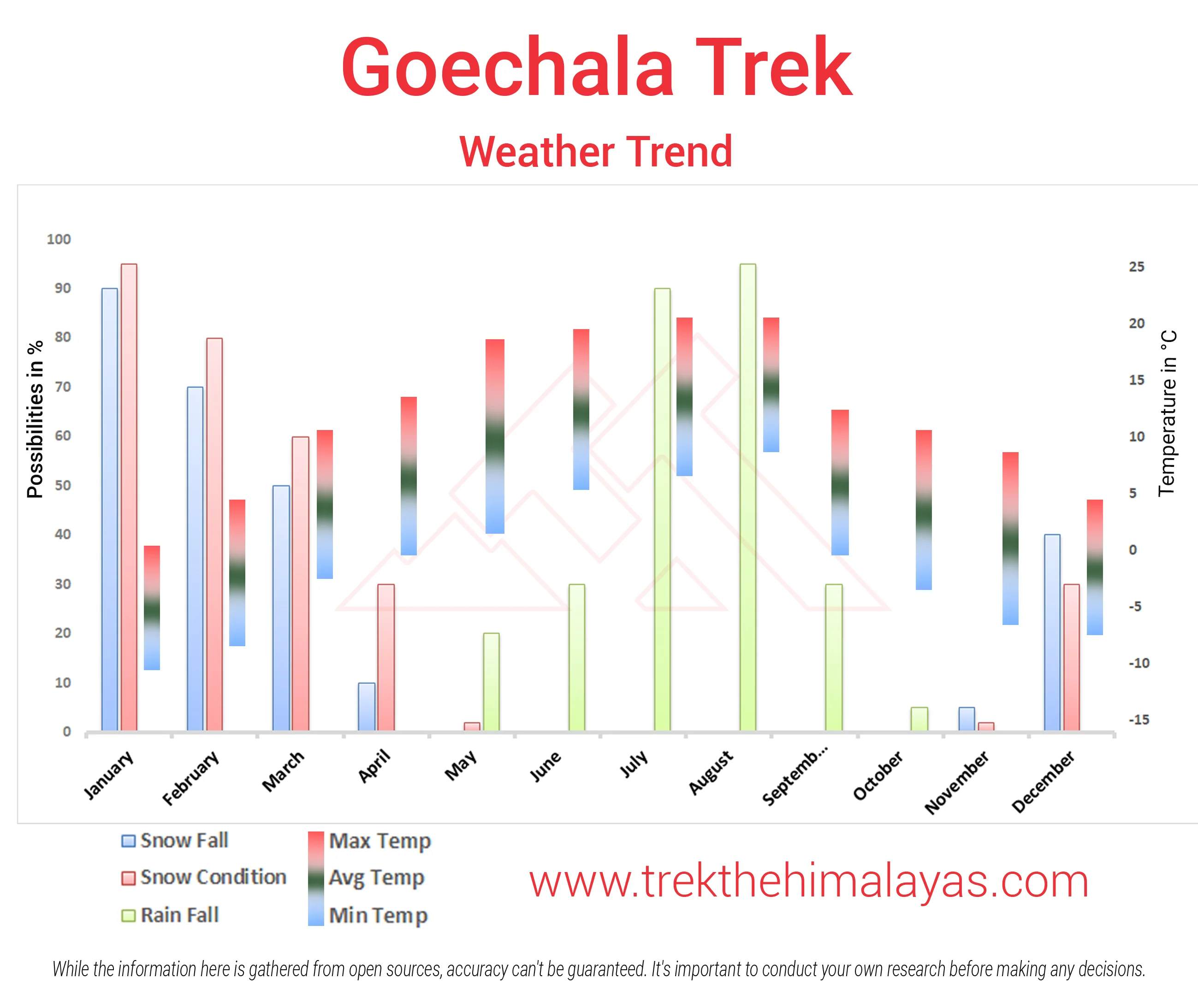
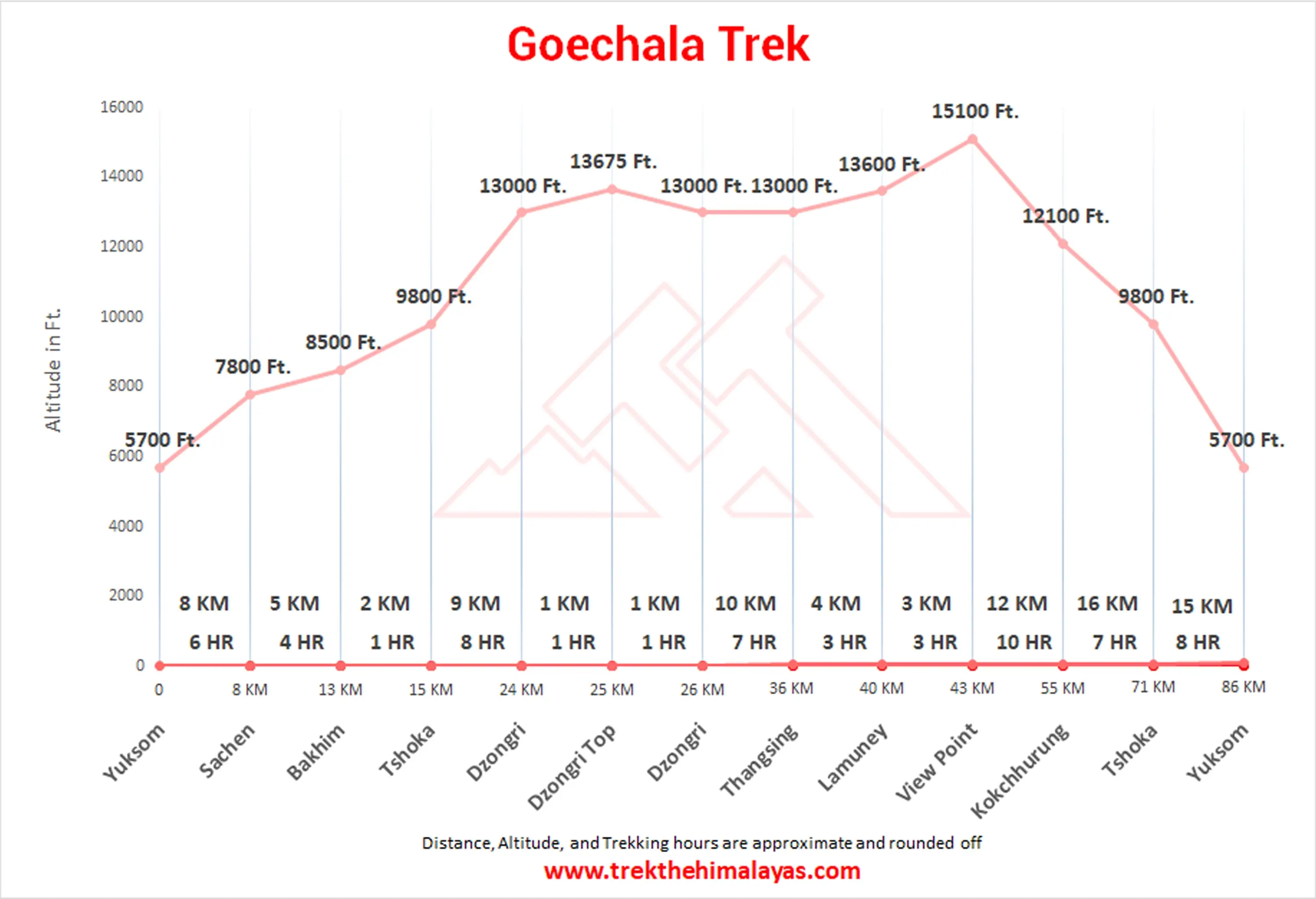
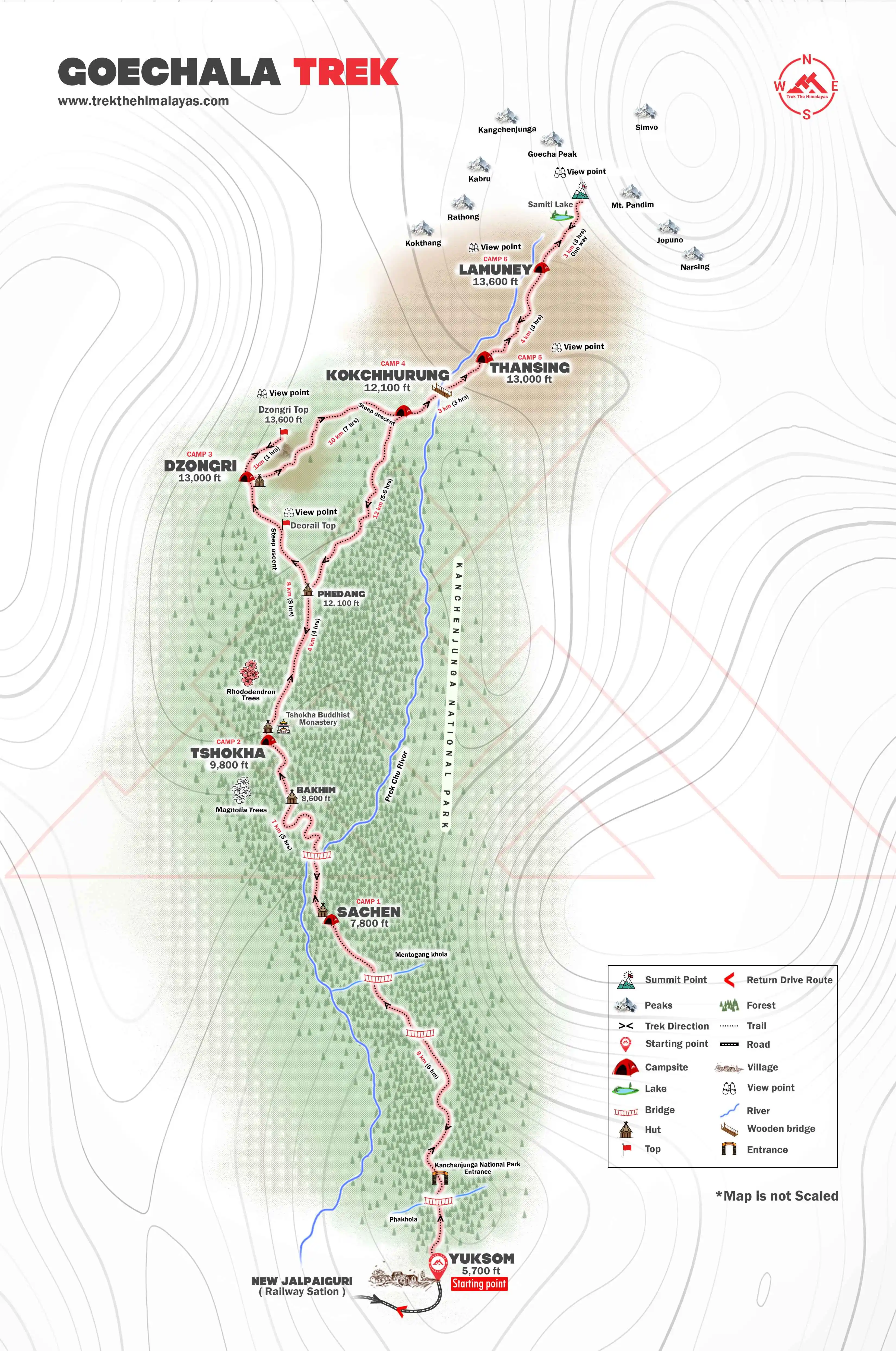
- Pulse rate at rest must be in between (60 to 90 beats per minute).
- Blood Pressure Reading must be in between (DIASTOLIC 70 – 90, SYSTOLIC 100 - 140 mm Hg).
- Respiratory rate at rest must be in between (12 to 20 breaths per minute).
- Should not have Liver and kidney issues.
- Should not have Diabetes Mellitus, Bronchial Asthma, Heart problems, Hypertension, etc.
- No pacemaker implant.
- People with Sinus issues, Epilepsy please contact to trek coordinator before booking the trek.
- If your BMI is not normal, Please contact our Trek coordinator before Trek booking.
Medical & Disclaimer Form (Mandatory Documents) Click here to download Medical & Disclaimer Form
- Government Employees can avail the benefit of Special Casual Leave (SCL) when they join us for a trekking expedition. As per the rules of the Pay Commission, Special Casual Leave can be availed for up to 30 days in a calendar year for trekking/mountaineering expeditions through a registered organization. Trek The Himalayas is a registered adventure tour operator by the Indian Mountaineering Foundation (IMF) and the Ministry Of Tourism (MOT).
- Trekkers have to apply for leave at least 20 days before the trek departure date.
- This service is exclusive to Indian government employees and is applicable only for treks within India.
- Do mail at info@trekthehimalayas to apply and mention your booked trek date and trek name.
- Junior trekkers (below 15 years) should have a company of parents/guardians.
- Trekkers between 15 to 18 years can come solo with the disclaimer form signed by parent/guardian.
- Medical & Disclaimer Form (Mandatory Documents) Click here to download Medical & Disclaimer Form
Important Links
- Click here to see Medical & Disclaimer Form (Mandatory Documents).
- Click here to know Importance of Lamuney Campsite
How To Reach
It is essential for everyone to arrive at New Jalpaiguri Junction (NJP) (10:00 am)
Once you have reached New Jalpaiguri Junction (NJP), TTH will manage the rest of your travel arrangements, if you have opted for TTH's pick-up service, you can select this option during the booking process by adding it as an add-on.
Options to reach New Jalpaiguri Junction (NJP) railway station.
1. Take a flight to Bagdogra Airport in West Bengal, and take a cab to NJP railway station, it’s 20 km away and will take 40 minutes.
- Domestic: There are various direct and indirect flights from other cities. You can take direct flights from Delhi, Kolkata, Guwahati and other cities.
- International: International terminal is well equipped with modern amenities. Druk Air is the airline which provides international flights to the passengers. International flights connect with Paro in Bhutan and Bangkok. These flights are direct and comfortable.
2. Take a train to New Jalpaiguri Junction (NJP) that is well-connected to major cities like Kolkata, Guwahati, Delhi and Mumbai.
( If you prefer to travel independently, you can either take a government bus or book a private cab. Your trek coordinator will provide guidance on how to arrange for the bus or cab booking. )
Drop-Off Information
- Arrive in New Jalpaiguri (NJP) between 4:00 pm to 5:00 pm.
- The designated drop-off point is NJP railway station.
- Please consider planning your subsequent travel arrangements after 8:00 pm.
- The distance from Railway Station to Bagdogra Airport is 20 km, it will take approx 40 minutes.
- TTH offers comfortable transportation through Xylo, Bolero, or equivalent vehicles. If you wish to upgrade your mode of transportation, please contact your trek coordinator for further assistance.
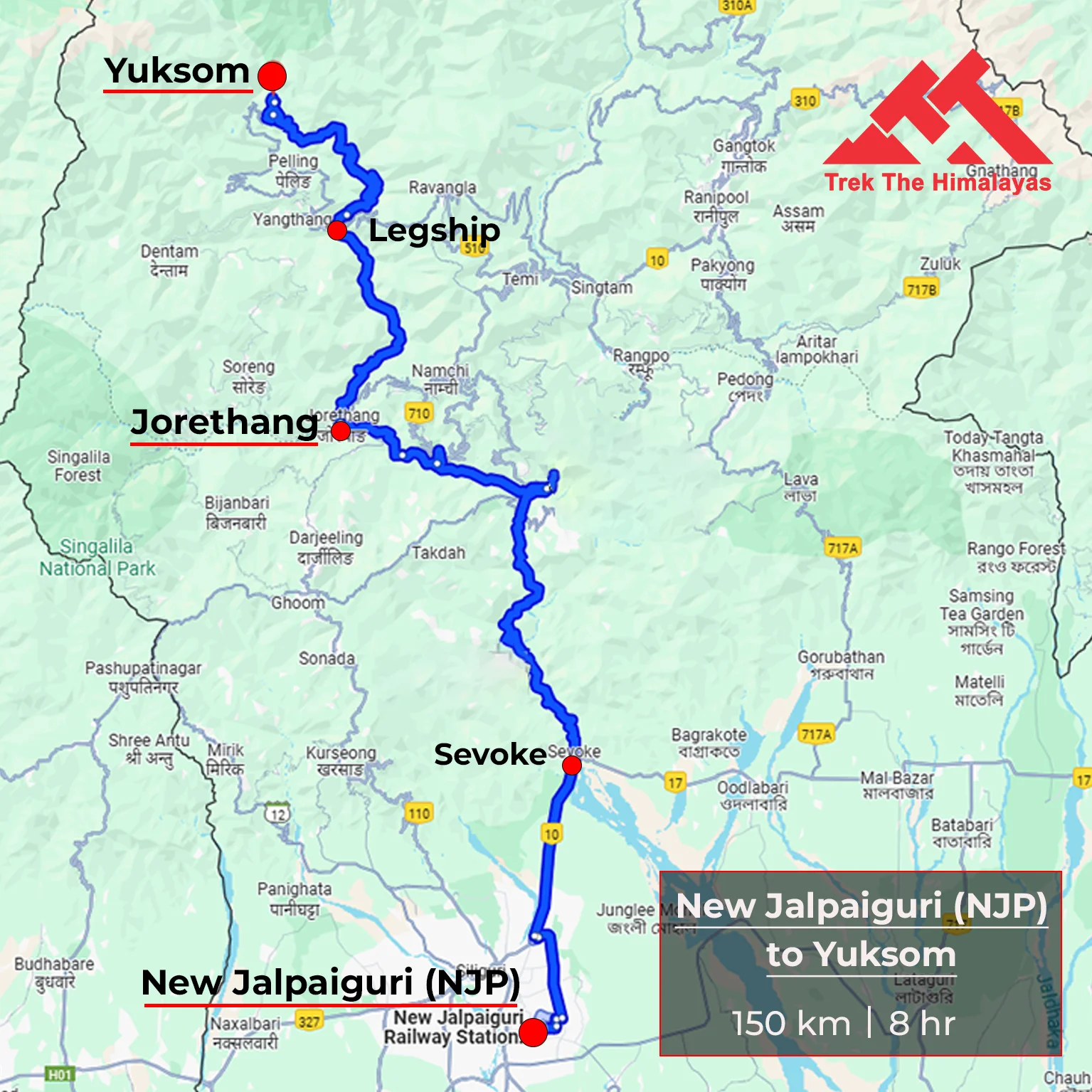
Cost Terms
Inclusion
1. Accommodation (as per the itinerary):
- Camping, Guest house during trek.
2. Meals (Veg + Egg):
- Meals while on trek (Veg + Egg).
- Day 1 Dinner to Day 10 Dinner.
3. Support:
- 1 Versatile base camp manager handles communication and deploys extra manpower in emergencies.
- 1 Mountaineering & First aid qualified professional trek Leader.
- 1 Experienced high-altitude chef.
- Local experienced guides (Number of guides depending on the group size).
- Enough support staff.
4. Trek equipment:
- Sleeping bag, Sleeping liners (if required), mattresses, and Utensils.
- 3 men all season trekker tent (twin sharing), Kitchen & Dining tent, Toilet tent.
- Camping stool, Walkie talkie.
- Ropes, Helmet, Ice axe, Harness, Gaiters & microspikes (if required).
5. First aid:
- Medical kit, Stretcher, Oxygen cylinder, Blood pressure monitor, Oximeter, Stethoscope.
6. Transportation (as per the itinerary):
- Transport from NJP to Yuksom and return. ( If booked through TTH, available upon booking in add-ons)
7. Mules/porters to carry the central luggage.
8. Cloakroom facility available at the base camp for additional luggage.
9. All necessary permits and entry fees, up to the amount charged for Indians.
10. Services from Yuksom to Yuksom.
11. Trek Completion Certificate.
Exclusion
1. Food during the transit.
2. Any kind of personal expenses.
3. Mule or porter to carry personal luggage.
4. Emergency evacuation, hospitalization charge, etc.
5. Anything not specifically mentioned under the head Inclusion.
Things can be provided on demand and availability (participant has to pay extra for these things).
1- Satellite phone/set phone - a type of mobile phone that connects via radio links via satellites orbiting the Earth instead of terrestrial cell sites like cellphones. Therefore, they can operate in most geographic locations on the Earth's surface.
Note: Satellite phones are prohibited in Leh-Ladakh, Kashmir, Sikkim due to security concerns related to its proximity to sensitive international borders. Only authorized personnel, like government officials and military, can use them with special permission from the Department of Telecommunications (DoT).
2- Gamow/PAC HAPO Bag (Portable Hyperbaric Bag) - is a unique, portable hyperbaric chamber for the treatment of acute mountain sickness (AMS), also known as altitude sickness.
3- AEDs (Automated External Defibrillators) - are portable life-saving devices designed to treat people experiencing sudden cardiac arrest, a medical condition in which the heart stops beating suddenly and unexpectedly.
Cancellation Terms
To request a cancellation, please email us at info@trekthehimalayas.com using your registered email ID.
Cancellations prior to 25 days from the start of the Trip
Refund Options
- 5% deduction of trek fee
- 100% cash voucher for any trip till one year
- Transfer your trek (any trek, any date) to your friend
Cancellation between 24 days and 15 days to the start of the Trip
Refund Options
- 30% deduction of trek fee
- 100% cash voucher for same trip till one year
- 85% cash voucher for any trip till one year
- Transfer your trek (same trek, any date) to your friend
Cancellation between 14 days and 10 days to the start of the Trip
Refund Options
- 50% deduction of trek fee
- 80% cash voucher for same trip till one year
- 70% cash voucher for any trip till one year
- Book the same trek, in the same season, with any other batch
- Transfer your trek (same trek, any date) to your friend
Cancellation less than 9 days to the start of the trek.
Refund Options
- No cash refund
- 20% cash voucher for the same trip till one year
- 10% cash voucher for any trip till one year
- Transfer your trek (same trek, same date) to your friend
Cancellation Policy (Emergency Cases):
In case of a death in the immediate family (parents, siblings, spouse, children) or if the trekker is hospitalized (min. 48 hours) or suffers a fracture (leg/arm) within a week before the trek, even if canceled a day before:
90% refund in cash
10% as a voucher (valid for 1 year, for any India trek)
Valid documents required. We’re here to support you during tough times.
Note- If a booking is made using a voucher or discount code, the policies related to vouchers and discounts cannot be modified.
In the unlikely event that TTH cancels a trek prior to the scheduled departure date:
While it is extremely rare for TTH to cancel a trek, we understand that unforeseen circumstances or natural disasters may occasionally require us to do so before the scheduled departure. These circumstances could include continuous rain or snow, thunderstorms, snowstorms, landslides, floods, earthquakes, or any other natural calamity that poses a risk to the safety of our trekkers. Additionally, unforeseeable events such as local riots, curfews, pandemics, lockdowns, government orders, or any similar situations that compromise the safety of the trekking experience may also necessitate a cancellation.
In the event of such a cancellation, TTH will provide you with a voucher equivalent to the amount you paid for the trek. This voucher can be redeemed for any of our treks within the next year, allowing you to still enjoy an adventure with us at a later date.
Note
-
The issuance of a voucher is not applicable in situations where you are required to descend from the trek for any reason. The trek leader may make the decision to send you down from the trek due to factors such as insufficient fitness level, symptoms of Acute Mountain Sickness (AMS), high blood pressure, exceeding the designated turn-around-time, health concerns, or if you are found smoking, drinking, or violating the rules set for the trek. In such cases, the provision of a voucher does not apply.
In the Rare Event that TTH Shifts a Trek
We would like to emphasize that weather conditions in high-altitude areas are highly unpredictable and can undergo sudden changes at any time, irrespective of the day. Additionally, circumstances beyond our control, such as natural disasters, political unrest, pandemics, and lockdowns, may impact the feasibility of conducting a trek. In cases where we are unable to proceed with an event due to such circumstances that are beyond our direct control, we will make every effort to provide you with an alternative trek that is safer and more suitable.
In such situations, we will issue a voucher to offset the cost difference between the originally scheduled trek and the alternative trek. This voucher can be redeemed at any time within one year from the date of issue. Please note that a refund fee or reimbursement of the cost difference is not applicable in these cases.
Note:
- Change of trek batch is dependent on the availability of seats in the batch
- In case of transferring a trek to a friend, he/she should satisfy all the mandatory requirements put forward by TTH
- TTH holds the right to change/cancel the policies, without prior notice
- Cash refund is applicable only in case of bookings made without using any promotional offer code or vouchers
Cash Voucher Terms
- This is a non-transferable voucher
- The voucher cannot be merged with any other offer of Trek The Himalayas
- The voucher is valid for Trek booked directly with Trek The Himalayas in India
- To avail the voucher please use your register phone number or e-mail id
- All the other Terms of booking a trek with Trek The Himalayas are applicable to the voucher
- Trek The Himalayas holds rights to add/remove any of the Terms and Conditions without prior notice
Itineraries are based on information available at the time of planning and are subject to change. "Trek The Himalayas" reserves the right to change expedition dates, people or itineraries as conditions warrant. If a trip must be delayed or the itinerary changed due to bad weather, road conditions, transportation delays, government intervention, airline schedules, sickness, or other contingency for which TTH or its agents cannot make provision, the cost of delays and/or other changes are the responsibility of the participant. TTH reserves the right to decline, or accept, any individual as a trip member for any reason whatsoever.
Trek Essentials
Rent EquipmentPDF Of Trek Essential Download
| Backpack with rain cover | (50 - 60 ltr) with comfortable shoulder straps |
| Day pack with rain cover | 20 - 30 ltr (If off-load opted) |
| Walking stick | Advisable (At least one) |
| Water Bottle / Hydration pack | 2 bottles of one liter each, People who use hydration pack 1 hydration pack and 1 bottle of one liter, Carry at least one thermos flask. |
| Small size tiffin/lunch box | 1 Nos |
| Snacks | Energy bars, dry fruits, electral/ors |
| Personal Medical Kit | Consult your doctor |
| T-Shirt (Synthetic quick dry) | 1 Full & 2 Half sleeves |
| Fleece T-shirt | 1 Nos |
| Wind stopper / Fleece jacket | 1 Nos |
| Windproof Jacket | 1 Nos |
| Down feather / Hollow jacket | 1 Nos |
| Thermal inner (Upper and Lower) | 1 Pair |
| Trek Pant (Synthetic quick dry) | 2 Nos |
| Wind stopper / Fleece Pant | 1 Nos |
| Waterproof gloves | 1 Pair |
| Fleece / woollen gloves | 1 Pair |
| Poncho / waterproof Jacket and pant | 1 Nos |
| Sunscreen | 1 Nos |
| Moisturiser | 1 Nos |
| Chap-stick / Lip balm | 1 Nos |
| Toothbrush and toothpaste | 1 Nos |
| Toilet paper & Wipes | 1 Nos |
| Soap / hand sanitizers | 1 Nos |
| Antibacterial powder | 1 Nos |
| Quick dry towel | 1 Nos |
| Head torch | 1 Nos. (Avoid Hand torch) |
| Sun Cap | 1 Nos |
| Woolen cap | 1 Nos. |
| Balaclava | 1 Nos. |
| Buff / Neck-gaiters | 1 Synthetic & 1 Woollen |
| Sunglasses | UV with dark side cover, People who wear spectacles - (A)- Use contact lenses | (B)- Photo chromatic glasses |
| Trekking shoes | 1 Pair (Waterproof, high ankle, good grip) |
| Floaters / flip-flops | 1 Pair |
| Cotton socks | 6 pairs |
| Woollen socks | 1 pairs |
| Gaiters | 1 Pair (TTH provides when required) |
| Micro spikes | 1 Pair (TTH provides when required) |

Frequently Asked Questions(FAQ)
To register with TTH, visit our website - www.trekthehimalayas.com and create your account. To create your account you will need to use your email address and fill in all the details, set your unique password and your account is ready to use.
- To book a trek with TTH, you first need to register with us and create an account.
- Choose the trek that you want to do and click on available dates.
- You will land at the login page, fill in the required details.
- Add Participants, choose add-on services click on the Pay now button, choose your preferred payment method, and make the payment. TTH accepts multiple payment options, including credit/debit cards, net banking, and UPI.
- You will receive a confirmation email from TTH with all the necessary details about the trek, including the meeting point, transportation, accommodation, and other important instructions.
- Click Here to watch Video
please send an email to us at info@trekthehimalayas.com or reach out to the numbers provided in the Help and Support section of your Trek Page. We will ensure that your issue is promptly resolved.
To book services such as off-load luggage and transportation, you can find them listed as add-ons. These additional services can be booked at the time of your initial booking. If you miss booking add-ons during the initial reservation, you can log in anytime and easily book 4 days before the departure date add-ons through the platform.
If you have booked the wrong trek or selected the wrong date, don’t worry! You can contact us at +91 9368882322 (Monday to Saturday, 10 AM to 10 PM) or email us at info@trekthehimalayas.com. You can also discuss this with your trek coordinator. Please make sure to inform us at least 10 days before the departure of your trek. Only then can we help you reschedule or arrange another trek for you.
We recommend visiting our "Suggest Me a Trek" page. By filling out the form, our experts will contact you with the best possible trek options based on your preferences and experience level. Alternatively, you can reach out to us via email at info@trekthehimalayas.com or give us a call using the numbers provided on our website for personalized assistance and recommendations.
Family treks differ from regular treks by focusing on ease of difficulty, offering shorter durations for younger participants, Kid-friendly and easily digestible foods, child-friendly activities, maintaining a higher guide ratio for diverse age groups, and implementing additional safety measures for families.
Family Trek with Kids recommendation Only Dayara Bugyal and Chopta Chandrashila Trek.
Minimum age for TTH treks is typically 7 years, though this may vary depending on the specific trek.
Yes, you can take a kids to a high-altitude trek with a parent. Discuss with a trek expert before booking a trek.
- Junior trekkers (below 15 years) should have a company of parents/guardians.
- Trekkers between 15 to 18 years can come solo with the disclaimer form signed by parent/guardian.
- Medical & Disclaimer Form (Mandatory Documents) Click here to download medical and disclaimer form
Physical Fitness: Ensure your child is physically fit. Engage them in regular exercise, outdoor activities, and hikes to build stamina and endurance. Hydration: Emphasize the importance of staying hydrated at high altitudes. Encourage your child to drink water regularly, even if they don't feel thirsty. Proper Nutrition: Provide a well-balanced diet with sufficient carbohydrates for energy and foods rich in iron to prevent altitude sickness. Adequate Sleep: Ensure your child gets enough sleep in the days leading up to the trek. Quality rest is crucial for altitude adaptation. Educate on Altitude Sickness: Teach your child about the symptoms of altitude sickness, such as headache, nausea, and dizziness. Encourage them to communicate any discomfort immediately. Appropriate Clothing and Gear: Dress your child in layers to adjust to changing temperatures. Ensure they have appropriate trekking gear, including sturdy footwear. Positive Mindset: Foster a positive mindset. Encourage your child, and let them know it's okay to take breaks when needed. Medical Check-Up: Schedule a medical check-up before the trek to ensure your child is fit for high-altitude activities. Consult with a healthcare professional about any potential health concerns.
TTH takes special care to provide wholesome and nutritious food for children on treks. Here are some of the foods that are typically served for children:
Breakfast: For breakfast, TTH serves a variety of options like porridge, cornflakes, bread, butter, jam, honey, boiled eggs, omelettes, and pancakes. Children can choose from these options to fuel themselves for the day's trek.
Lunch: For lunch, TTH serves lunch which includes rotis, vegetables, rice, dal, and salad. The rotis are usually made fresh on the trek and are a good source of carbohydrates. The dal and vegetables provide protein and other essential nutrients.
Snacks: TTH provides healthy snacks like fresh fruits, dry fruits, energy bars, cookies, and biscuits to keep the children energized throughout the day.
Dinner: For dinner, TTH serves a hot and wholesome meal which includes soup, rice, dal, vegetables, and a non-vegetarian dish (if requested in advance). Children can also choose from a variety of desserts like custard, jelly, and fruit salad.
Dietary requirements: If a child has any special dietary requirements, TTH can cater to those needs as well. For example, if a child is lactose intolerant or allergic to nuts, the kitchen staff can make arrangements to accommodate those requirements.
Choosing the right trek for a beginner can be a bit overwhelming as there are many factors to consider such as distance, elevation gain, terrain difficulty, weather, and time of year. Here are some tips that can help you choose the right trek for a beginner:
1. Determine fitness level: Assess the fitness level of the beginner to understand their physical capabilities. This will help you select a trek that is challenging but not too difficult.
2. Choose a well-traveled trail: A well-traveled trail will have more amenities such as signposts, water stations, and shelter. It is also safer as there will be other hikers on the trail.
3. Consider the length of the trek: For beginners, it is recommended to start with a shorter trek that can be completed in a day or two. This will help them get acclimatized to trekking and build their confidence.
4. Look for gradual elevation gain: Choose a trek with a gradual elevation gain rather than steep ascents. This will make the trek easier and more enjoyable.
5. Check the weather: Check the weather forecast before selecting a trek. Avoid treks during the monsoon season or winter when the trails can be slippery or dangerous.
6. Research the trail: Read about the trail to get an idea of the terrain, altitude, and difficulty level. This will help you select a trek that is suitable for the beginner.
7. Consult with an expert: If you are unsure about which trek to choose, consult our trek expert Mr. Nitin (+91 70600 59773) between 10 AM to 6 PM (Tuesday - Friday). Mr. Nitin will provide you valuable advice and guidance.
Overall, it is important to choose a trek that is enjoyable, challenging but not too difficult, and suitable for the beginner's fitness level and experience.
It is not recommended for a beginner to choose a difficult Himalayan trek. Trekking in the Himalayas can be physically and mentally challenging, especially if you are not used to the high altitude, steep slopes, and rugged terrain. Choosing a difficult trek without the proper experience, fitness level, and preparation can be dangerous and put you at risk of altitude sickness, injury, and other hazards.
If you are a beginner, it is recommended to start with an easier trek and gradually build up your skills and experience. This will help you understand the challenges of trekking in the Himalayas, and also prepare you physically and mentally for a more difficult trek in the future. It is also important to choose a trek that matches your fitness level, experience, and interest.
There is no specific age limit for a beginner trekker. However, it is important to consider your physical fitness, health condition, and personal interests before embarking on a trek. Trekking in the Himalayas can be physically and mentally demanding, and requires a certain level of physical fitness and endurance.
If you have any pre-existing medical conditions or are above a certain age, it is recommended to consult with a doctor before embarking on a trek. It is also important to listen to your body and take breaks as needed during the trek to prevent exhaustion or injury.
We recommend visiting our "Suggest Me a Trek" page. By filling out the form, our experts will contact you with the best possible trek options based on your preferences and experience level. Alternatively, you can reach out to us via email at info@trekthehimalayas.com or give us a call using the numbers provided on our website for personalized assistance and recommendations.
Yes, you can join the trek. We have fixed departure groups where you can simply book your trek and we will take care of curating a group.
Before you start the trek, it is recommended that you make all the necessary phone calls as during the trek you may or may not receive network coverage, once you come back to the Base Camp, you can reconnect with your family via phone once again. You can share your trek coordinator contact detail with your family members to get the latest updates about your trek batch.
At TTH, we provide wholesome and nutritious meals during the trek. The food is vegetarian and includes a variety of dishes such as rice, dal, vegetables, chapati, paratha, pasta, noodles, and soup. We also offer snacks such as biscuits, and salty, and dry fruits during the trek. Special dietary requirements such as vegan, gluten-free, or Jain food can also be arranged if informed in advance.
If you are allergic to some foods, you need to let us know in advance so that we can make arrangements accordingly.
TTH is a trekking company that prioritizes the safety of all its participants, including women trekkers. We have a comprehensive safety system in place, which includes a dedicated team of experienced and trained trek leaders and support staff who are equipped to handle emergency situations and provide first aid.
TTH also takes specific measures to ensure the safety and comfort of women trekkers. They have a separate tent accommodation for women trekkers, female trek leaders, and support staff. They also provide separate toilet facilities for women and encourage a safe and respectful environment for all trekkers.
Moreover, TTH has a strict policy against any kind of harassment and has a zero-tolerance policy towards such incidents. They have a designated Internal Complaints Committee (ICC) to investigate and address any complaints related to harassment or misconduct. Overall, TTH has a good reputation for safety and responsible trekking practices, and women can feel comfortable and safe while trekking with them.
In case you are the only women in the group, we provide a single sleeping arrangement. Also, during the trek, the trek leader will always remain by your side to provide optimum safety and reassurance.
You can reach out to the trek coordinator to inquire about the number of female trekkers and their respective states who have booked the trek. Please note that the trek coordinator cannot disclose personal details of any trekker. Once you've confirmed your booking, a WhatsApp Group will be created for all the trekkers in your batch. This allows you to connect with fellow trekkers before the trek begins.
While many of our treks are led by female trek leaders, however, it is not possible to know which trek leader is assigned to which group. But nonetheless, whether the trek leader is male or female you can be completely assured of your safety and security with us.
Yes, it is possible to trek with periods. However, it is important to take some extra precautions and preparations to ensure a comfortable and safe trekking experience. Here are some tips that can help you trek during your period:
1. Use menstrual hygiene products that you are comfortable with, such as tampons, pads, or menstrual cups. It is recommended to carry enough supplies for the entire duration of the trek.
2. Pack wet wipes, hand sanitizer, and plastic bags to dispose of used hygiene products.
3. Wear comfortable and breathable clothing that allows for easy movement and reduces friction. Avoid wearing tight or restrictive clothing that can cause discomfort.
4. Carry pain relief medication, such as ibuprofen or acetaminophen, in case of menstrual cramps.
5. Stay hydrated and maintain a balanced diet to support your energy levels and overall health.
6. Take breaks as needed and listen to your body. If you feel uncomfortable or experience any unusual symptoms, seek medical attention immediately. It is also recommended to consult with a doctor before going on a trek during your period, especially if you have a pre-existing medical condition or are taking medication.
By taking necessary precautions and being prepared, you can have a safe and comfortable trekking experience even during your period. We provide proper disposal facilities for sanitary pad disposal during the trek.
We offer three person tents with twin-sharing for optimum comfort. A woman trekker will share a tent with another woman trekker and if you are the only woman in the group, you will be given a single accommodation for your comfort and privacy.
Yes, we do provide gears on rent. You can book it using you TTH account directly.
Mountaineering qualified Experienced and first aid certified Trek Leader, First Aid Certify local guide, Cook, helpers and supporting staff.
People suffering from Bronchitis, Asthma, High blood pressure, Epilepsy (got faints), TB , Heart problem or on higher BMI side are strictly not allowed to go on any Himalayan trek. Apart from this if you had any medical history, please let us know.
No. Alcohol and smoking isn’t allowed while on trek. It is totally misconception that it will keep you warm. Your body need to acclimatize properly and for that eat properly and drink enough water; these things will keep you warm.
Toilet tents provide a convenient solution for answering nature's call in the great outdoors. Dry toilets, in particular, offer a highly sanitary approach. By digging a pit and utilizing mud and a shovel, you can easily cover up your waste. This method ensures cleanliness and hygiene while camping or exploring in the forest.
Remember to pack essential toiletries to complete your outdoor bathroom kit and maintain proper personal hygiene during your adventures. With these practices in place, you can enjoy nature while also respecting it.
Layer Up From Head To Toe
Eat Full Meals, never sleep empty stomach
You can keep warmee (if you’re more susceptible to cold).
Use sleeping bag in right way and don’t leave free space in sleeping bag.
For upper body
– Thermal layer
– T-shirt (full-sleeves)
– Fleece T-shirt (for extreme colds)
– Fleece layer
– Thick Jacket/Down Jacket
– Waterproof or Windproof layer (outermost layer, when it is snowing or raining)
- For Lower Body
– Thermal layer
– Hiking pants (normal) or Winter hiking pants
Based on how warm you feel you can skip any of the above layers. Your outer later should be windproof since it is windy at high altitude.
The idea behind layering is that the more insulation you have the less cold you feel, and instead of wearing a very thick jacket if you wear multiple layers, your body will be better insulated against the cold.
Yes, we provide micro spikes and gaiters, if required.
Mandatory documents: 2 xerox of ID having address (addhar card/driving license), 2 Passport size photographs, hard copy Medical form signed & sealed by doctor, disclaimer form sign by trekker and high altitude insurance.
No. We don’t but we can suggest you good hotel/Stay nearby pick up location.
Yes, trekker must carry 2 water bottles 1 litre each so they can refill it at campsite for drinking and keep themselves hydrate.
You should buy shoes which has these three features –Good grip, Ankle Support and additional water resistant layers. Generally, we advise Quechua Trek 100, MH 500 and MH 100.
No one is forced to go on. There is always enough staff to split the party according to need and regroup later at the camp. Most people have no trouble reaching the highest campsite. If some members decide not to climb the final distance they can wait for the climbers to come back down the same way or take a lateral path to the descent route.
Trek The Himalayas is the safest and most trusted trekking organization in India. Our deep expertise and commitment ensure that each trekker can fully immerse in the Himalayan beauty while experiencing a well-organized and memorable journey. We are proud to be recognized among the best trekking companies in India and have been awarded the PHD Samman Award two years consecutively for Best Adventure Tour Operator. Our founders, themselves are proficient mountaineers and belong to the hilly states of India. At TTH we follow all the safety protocols. Our Trek Leaders are expertly trained in First Aid and Acute Mountain Sickness (AMS) management. The extensive experience is a key factor in establishing us as the best trekking company in India.
Explore the best trekking companies in India and see what sets them apart.Yes, Trek The Himalayas (TTH) provides customized trekking packages, and premium trek packages, apart from fixed departures tailored to your preferences and needs. We understand that each trekker has unique interests, timeframes, and fitness levels, so we are happy to design a customized trek package that aligns with your goals. If you are seeking a specific experience, such as camping under the stars, a photography-focused trek, or an itinerary that includes cultural and heritage sites, our team can help create the ideal trekking package for you.
With a customized trek, you have the flexibility to choose aspects like trek difficulty, duration, group size, and even special add-ons like guided tours of nearby villages or extended camping nights at scenic locations.
Our customization options are ideal for families, groups, corporate teams, and solo adventurers looking for a tailored journey through the Himalayas.
Yes, you need special permits for Trekking in India, especially in protected or restricted areas. In states like Uttarakhand, Himachal Pradesh, and Ladakh, trekkers may need to obtain permits from local authorities or forest departments before starting their journey. For international trekkers, special permits like the Inner Line Permit (ILP) are required for regions such as Ladakh and Arunachal Pradesh. To make the process easier, Trek The Himalayas assist adventurers in obtaining all the necessary paperwork and permits, ensuring a hassle-free trekking experience.
Trek The Himalayas is committed to promoting Sustainable Tourism and Eco-Friendly Tourism by following responsible trekking practices and encouraging our trekkers to do the same.
We have introduced impactful initiatives like Heal Himalaya and Leave No Trace. Through these programs, we regularly organize cleaning drives along trekking routes and surrounding areas to keep the trails free from litter. Our team carries trash bags during every trek, ensuring that all waste collected from the slopes is brought back to the base and disposed of properly. We also take active steps to reduce plastic waste by completely avoiding the use of single-use plastics and encouraging our trekkers to do the same. Small changes like carrying reusable bottles and eco-friendly alternatives can make a big difference in protecting the environment.
By choosing to trek with us, you become a part of this movement toward responsible and sustainable trekking.
Yes, Trek the Himalayas provides trekking tours to well-known pilgrimage sites, including Kailash Mansarovar Yatra, Adi Kailash Yatra, Char Dham Yatra, and Panch Kedar.
Trekking in India offers something for everyone, from easy trails for beginners to tough and challenging routes. If you're planning to go for high-altitude or difficult treks like Kang Yatse or Pin Parvati, it's better to have some prior trekking experience.
However, if you're new to trekking, there are many beautiful and beginner-friendly options to start with, like Dayara Bugyal, Ali Bedni, Chandrakhani Pass, Sandakphu, Surya Top, and many others. Your preparation depends on the trek you choose. Easier treks need basic fitness, while tougher ones require more training and experience.
India offers a wide range of beautiful treks, and the best one really depends on your fitness level, experience, and what kind of views or adventure you’re looking for. Here are some of the most popular and well-loved treks:
Sandakphu Trek, Sikkim/West Bengal – Famous for views of four of the five highest peaks in the world.
Dayara Bugyal Trek, Uttarakhand – A perfect choice for beginners with scenic meadows and easy trails.
Ali Bedni Bugyal Trek, Uttarakhand – Known for its lush meadows and close views of Mount Trishul and Nanda Ghunti.
Pin Bhaba Pass Trek, Himachal Pradesh – A stunning crossover trek with changing landscapes.
Kashmir Great Lakes Trek, Jammu and Kashmir – One of the most beautiful treks in India, with alpine lakes and valleys.
Ranthankharak Trek, Uttarakhand – A less-crowded trail offering peace and beautiful mountain views.
Valley of Flowers Trek, Uttarakhand – A UNESCO World Heritage Site, famous for its vibrant blooms during monsoon.
Choose the one that matches your fitness and interest, and you’re in for an unforgettable experience.
Deciding which Indian state has the "best" trekking is tough, as it really depends on what you're looking for. However, Himachal Pradesh and Uttarakhand consistently stand out as top contenders, both offering incredible variety and stunning Himalayan scenery.
Himachal Pradesh is a trekker's paradise, boasting the Dhauladhar, Pir Panjal, Shivalik, and Zanskar ranges. Uttarakhand, often called the "Land of Gods," also has an abundance of beautiful trails. Its Garhwal and Kumaon regions feature iconic treks through lush alpine meadows that turn into snowy landscapes in winter.
Apart from Himachal and Uttarakhand Sikkim (with views of Kanchenjunga) and parts of Jammu & Kashmir (like the Kashmir Great Lakes trek) also offer unique and exceptional experiences. Ultimately, the "best" state depends on your preference for lush valleys, spiritual paths, or remote mountain adventures.
For beginners, one of the best trekking options is the Nag Tibba trek in Uttarakhand. It’s an easy to moderate trek, perfect for first-timers. The trail offers beautiful mountain views, takes just a couple of days, and gives a good idea of what trekking in the Himalayas feels like.
Other beginner-friendly treks that are slightly longer but still manageable include Kedarkantha, Bhrigu Lake, Kuari Pass, and Dayara Bugyal. These treks are not very tough and give you more time in the mountains, with amazing scenery and a great learning experience.
To start trekking in India, follow these simple steps:
1. Choose an easy trek: Pick a beginner-friendly trek that matches your fitness level. Go for shorter and well-marked routes that don’t have very steep climbs or high altitudes. Treks like Chopta–Chandrashila, Nag Tibba, or Dayara Bugyal are great options to begin with.
2. Work on your fitness: Start getting fit a few weeks before your trek. Focus on building stamina by walking daily, especially on stairs or slopes. Jogging, cycling, or light exercises to strengthen your legs and core will also help you enjoy the trek better.
3. Get the right gear: Invest in a few good essentials, comfortable trekking shoes, a light but strong backpack, and layered clothing that works for changing mountain weather. Don’t forget basics like a water bottle, headlamp, and trekking poles for better comfort and safety on the trail.
With the right planning and preparation, trekking can be a fun and unforgettable experience!
The “most beautiful trek in India” can vary from person to person, but some treks are widely known for their scenic views. Valley of Flowers, Hampta Pass, Pin Bhaba Pass, and Kashmir Great Lakes are often considered the most scenic treks in the country.
These treks have some of the best landscapes, snow-covered mountains, lush green meadows, crystal-clear rivers, and in some places, vibrant wildflowers spread across the valley. The mix of colors, natural beauty, and peaceful surroundings make these treks a visual treat for every nature lover.
The best time for Goechala Trek is from April to mid-May, Spring, and September to early November, Autumn. In spring the rhododendrons are in full bloom in various shades of red, pink, and white. In autumn you can see clear skies and stunning mountain views.
The Goechala Trek is considered difficult and requires good physical fitness and stamina. It is a high-altitude trek, covering 90 km over 11 days, with long walking hours and challenging terrain. The trails are rocky and uneven, and the weather can be unpredictable, making the trek even tougher. Proper acclimatization is essential to avoid Acute Mountain Sickness (AMS) and adjust to the altitude. If you’re well-prepared and up for a challenge, this trek offers stunning Himalayan views and an incredible adventure!
The Goechala trek offers beautiful views of Kanchenjunga peak, the third-highest peak in the world. Along the way, you'll walk through vibrant rhododendron forests, where flowers bloom in different shades, and you might spot exotic bird species adding to the beauty of the trail. The trek also takes you to serene high-altitude lakes and gives you a chance to experience the unique culture of remote Himalayan villages.
At the trek, you can expect the temperature to be at around 0 degrees C to 20 degrees C during spring/summer during the daytime and it can dip to as low as - 1 degrees C at night. In autumn and winter, the temperature lingers between -4 degrees C to - 5 degrees C, making the trek even more challenging.
The Goechala Trek with Trek the Himalayas is an 11-day adventure. The itinerary is well-planned, including acclimatization days to help you adjust to the altitude and enjoy the trek to the fullest.
To do the Goechala Trek, you need a Sikkim Inner Line Permit, which is mandatory for all trekkers. If you are a foreign national, you will also need a Restricted Area Permit.
For the Goechala Trek, pack warm clothing, sturdy trekking shoes, trekking poles, a first-aid kit, and personal toiletries. Also, bring along snacks and energy bars to keep your energy levels up during the trek.
Yes, the Goechala Trek has a risk of altitude mountain sickness (AMS) due to its high elevations. The trek involves long trekking hours, often taking you to altitudes above 15,000 feet, where the air gets thinner, and oxygen levels drop. To minimize the risk of AMS, it is crucial to acclimatize properly, which is why the itinerary includes acclimatization days. Staying well-hydrated, maintaining a steady pace, and listening to your body are also key to staying safe and healthy on this challenging trek. If you experience symptoms like headache, nausea, or dizziness, inform your trek leader immediately to avoid serious health risks.
Yes, a pair of trekking sticks is highly recommended for this long and challenging trek. You can rent trekking sticks from the Trek the Himalayas rental store for extra support and stability on the trail.
For the Goecha La trek, it’s essential to dress in layers. Wear moisture-wicking base layers, followed by insulating layers like fleece or down jackets, 2-3 trek pants, 4-5 pair socks, warm gloves, sun cap, hat, fleece cap, and thermal inners. Don’t forget to bring thermal innerwear, a hat, gloves, and a scarf or buff to protect against the cold.Improvise, use simple and similar words.
The best treks to do in Sikkim are Bajre Dara and Goechala.
The highest point of the Goechala Trek is Viewpoint 1, which stands at an altitude of 15,100 feet. From this spot, you will be rewarded with amazing views of the surrounding mountains. One of the main highlights is the stunning sight of the Kanchenjunga peak, which looks even more magical at sunrise when the golden light slowly spreads across the snow-covered peaks, creating an unforgettable experience.
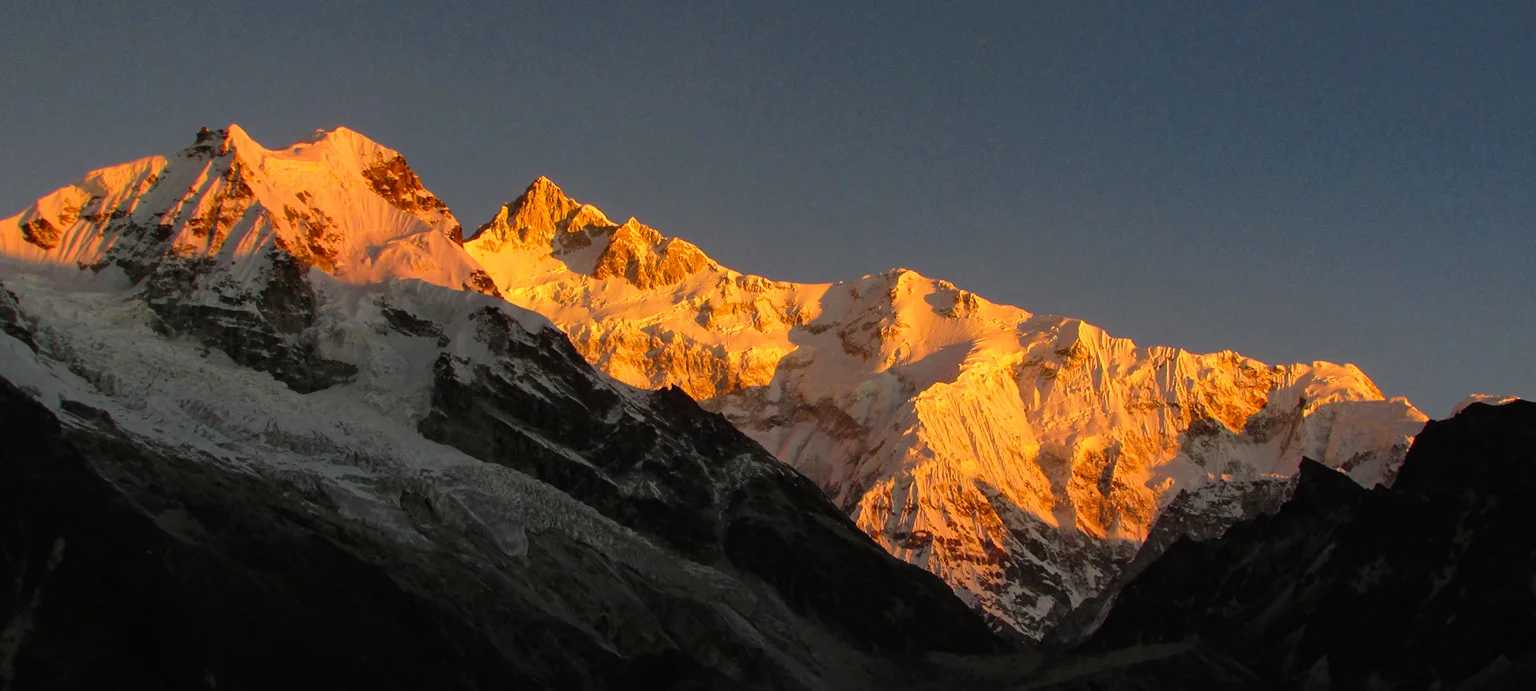
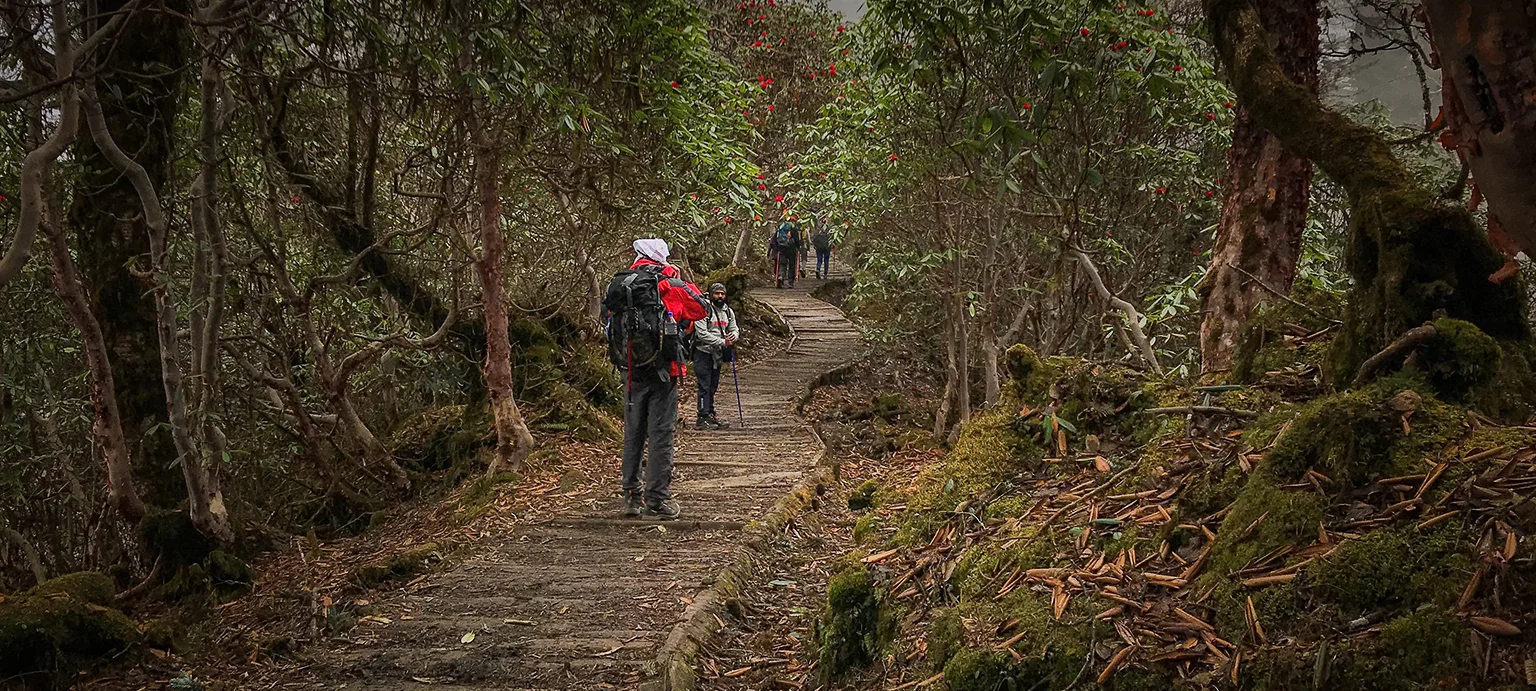
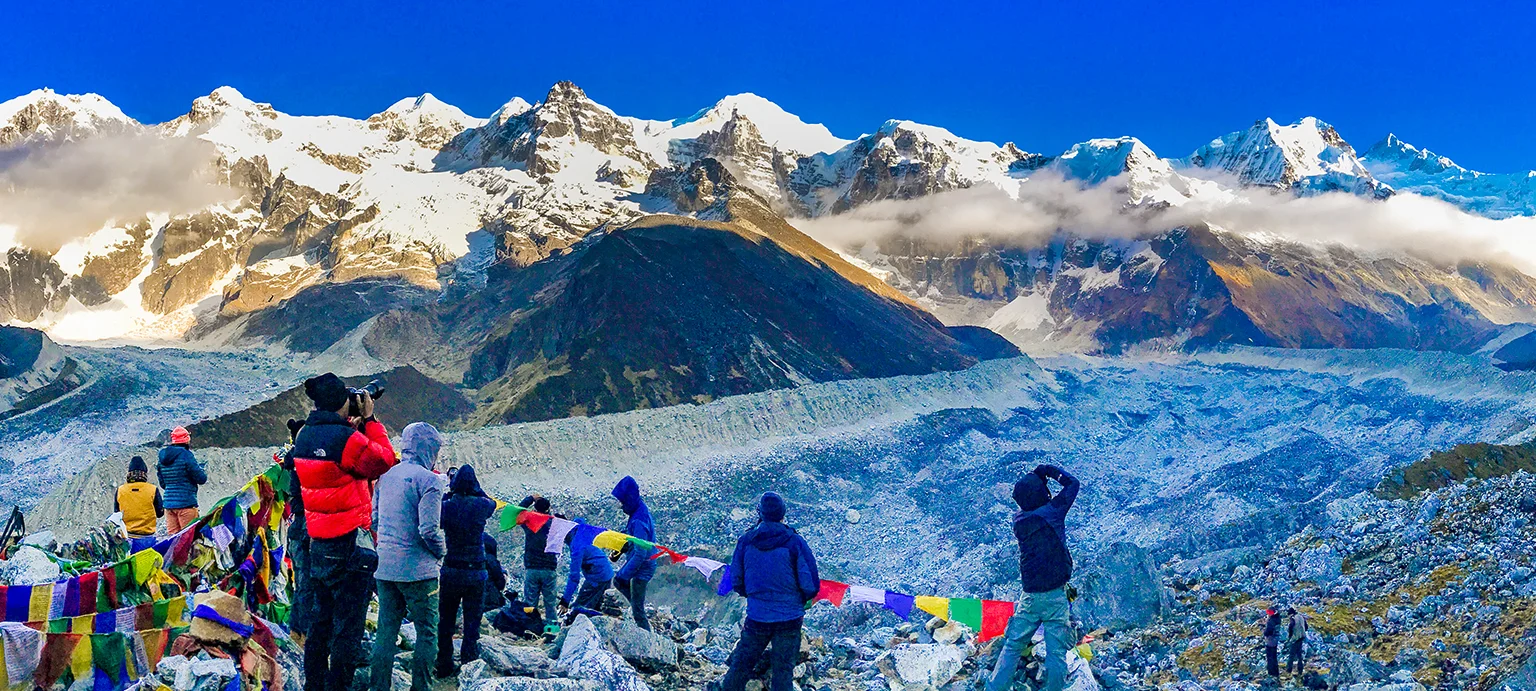
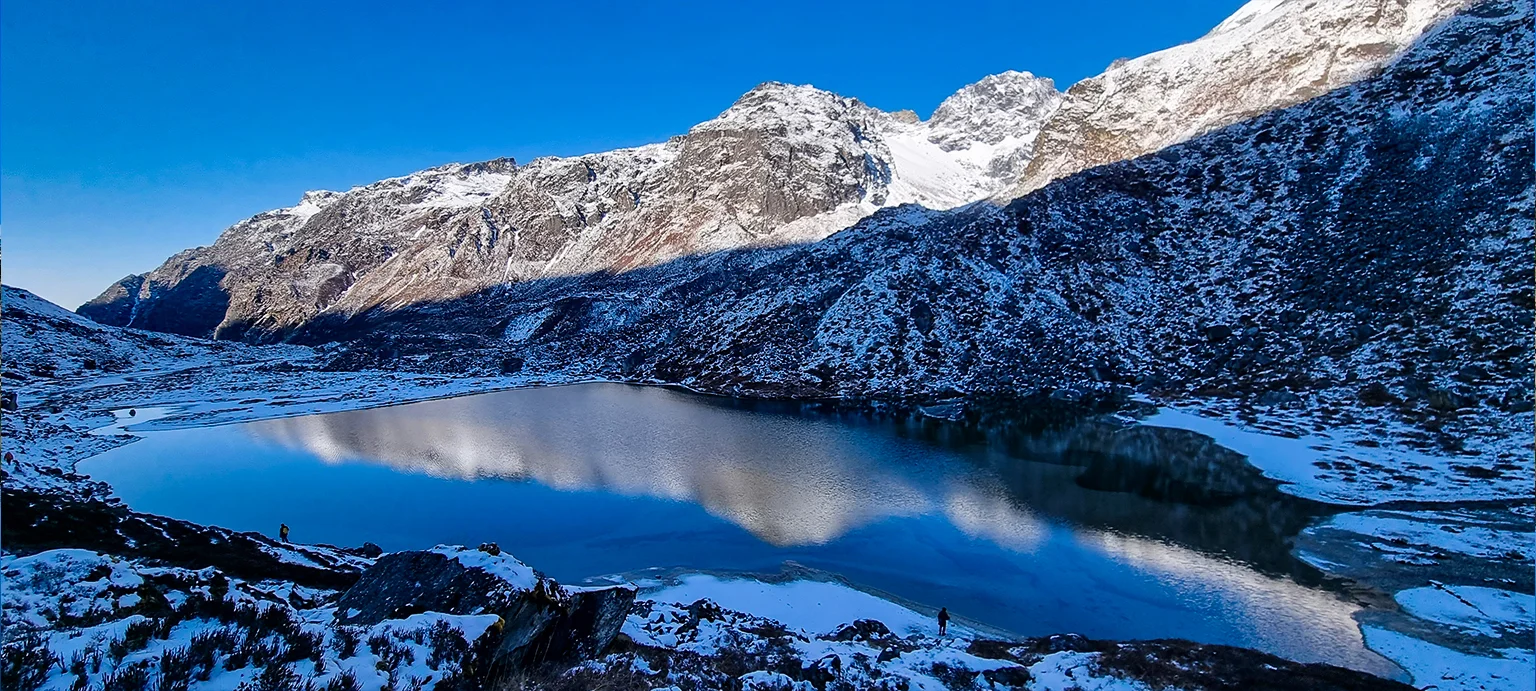
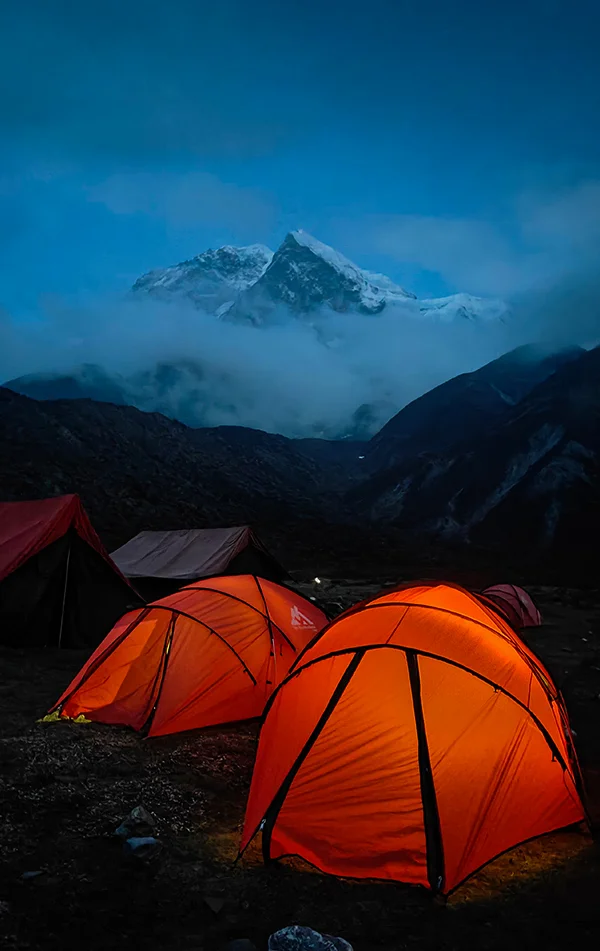
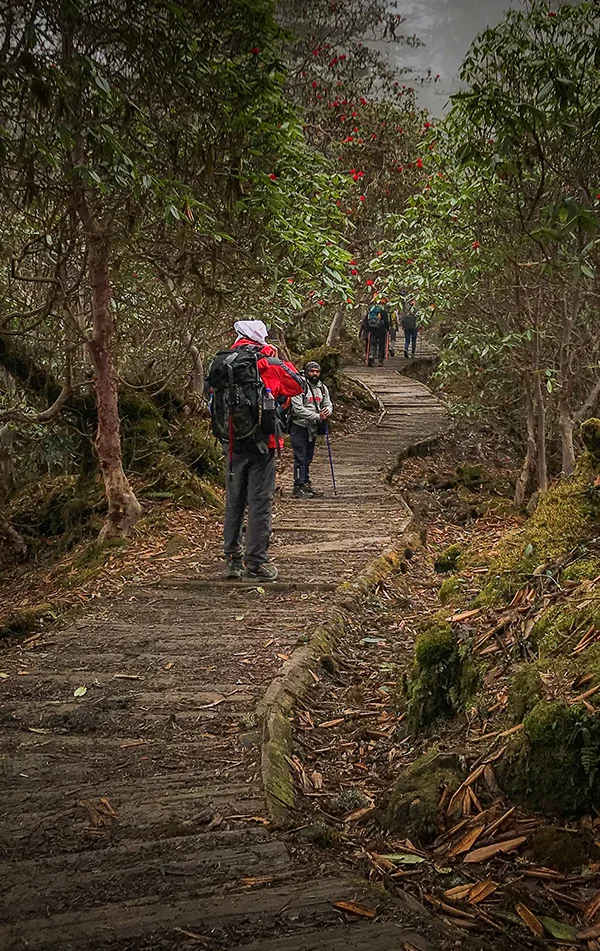
.webp)
.webp)
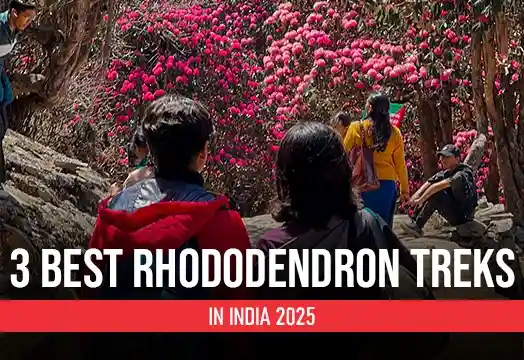
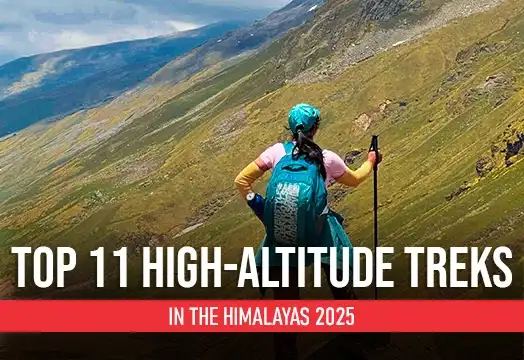
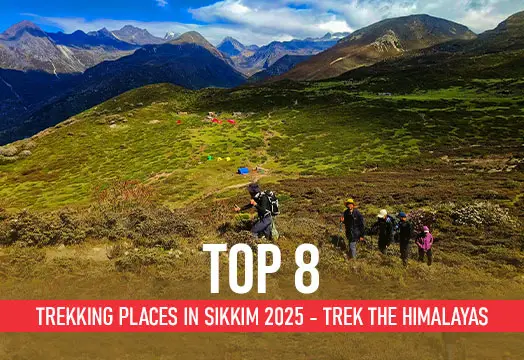
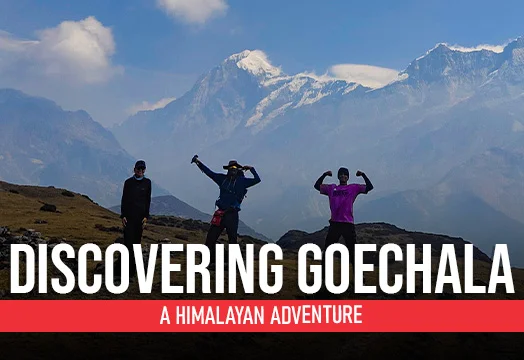
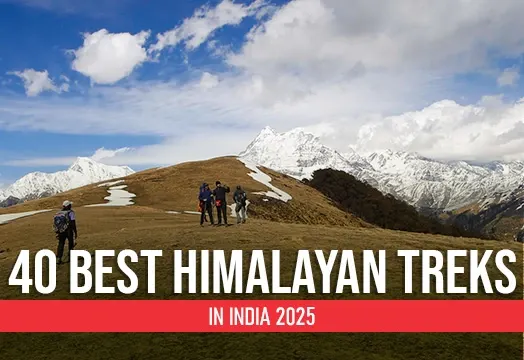
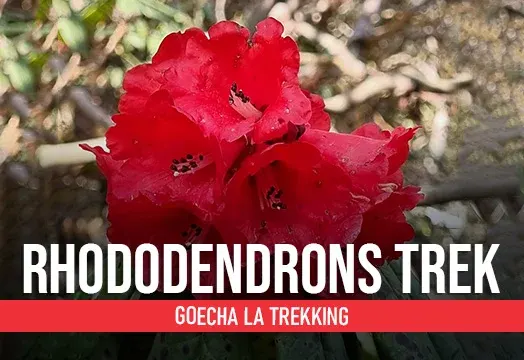
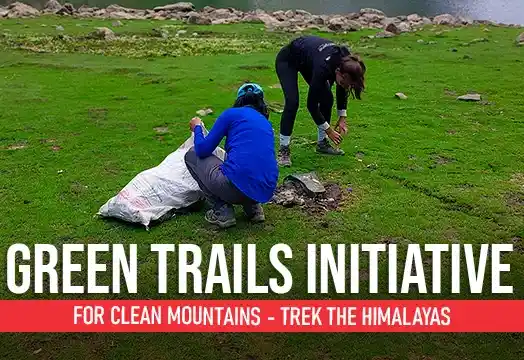
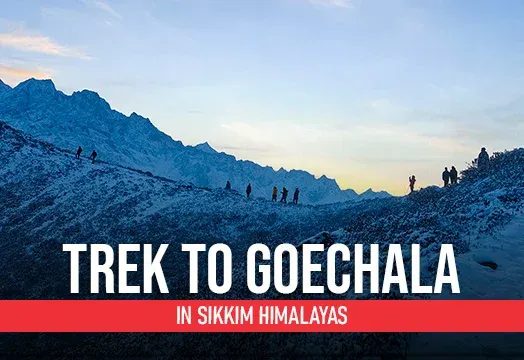
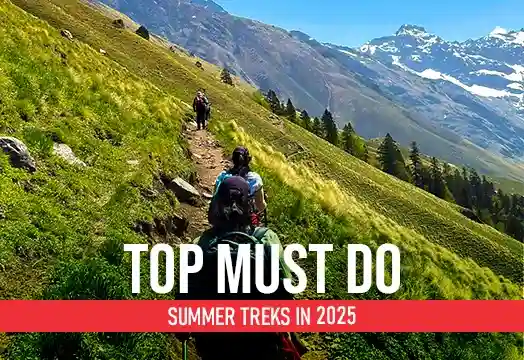
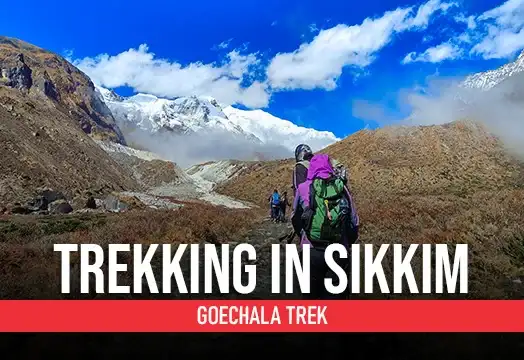
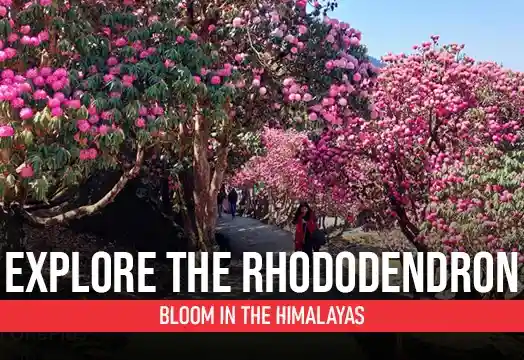
.webp)
